- ALDX Dashboard
- Financials
- Filings
-
Holdings
- Transcripts
- ETFs
- Insider
- Institutional
- Shorts
-
8-K Filing
Aldeyra Therapeutics (ALDX) 8-KRegulation FD Disclosure
Filed: 29 Mar 22, 8:12am
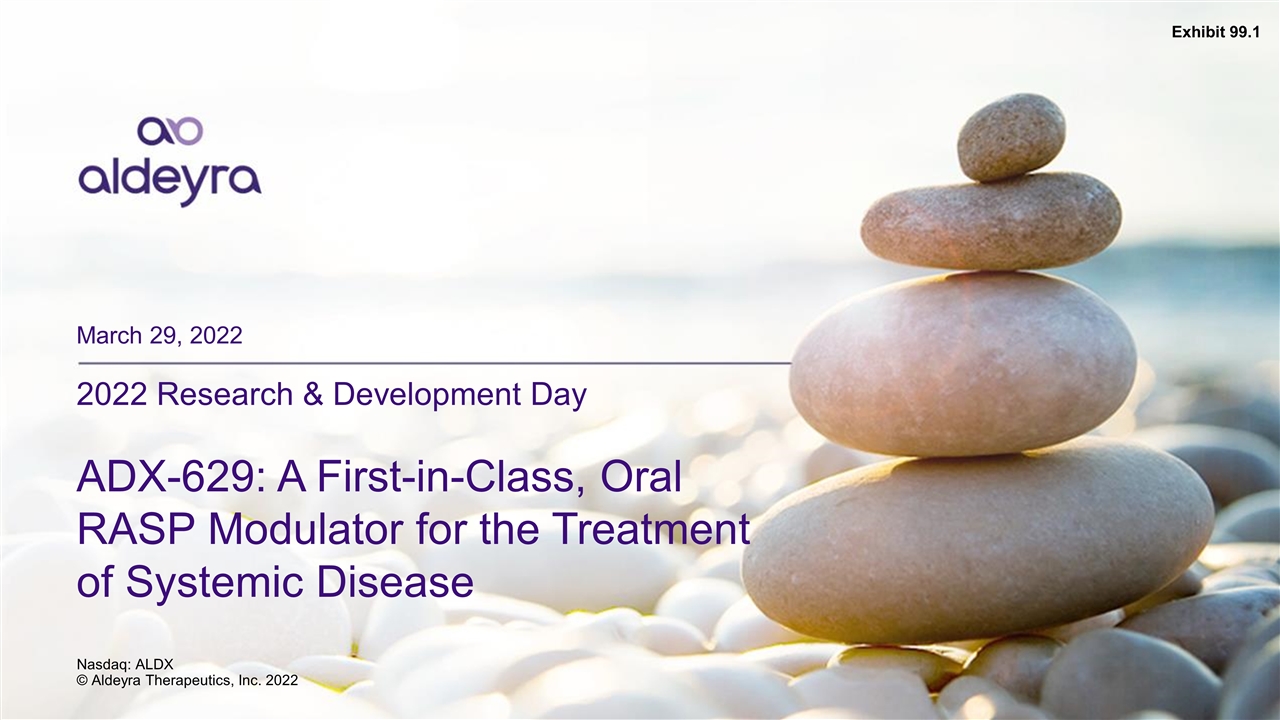
ADX-629: A First-in-Class, Oral RASP Modulator for the Treatment of Systemic Disease 2022 Research & Development Day March 29, 2022 Nasdaq: ALDX © Aldeyra Therapeutics, Inc. 2022 Exhibit 99.1
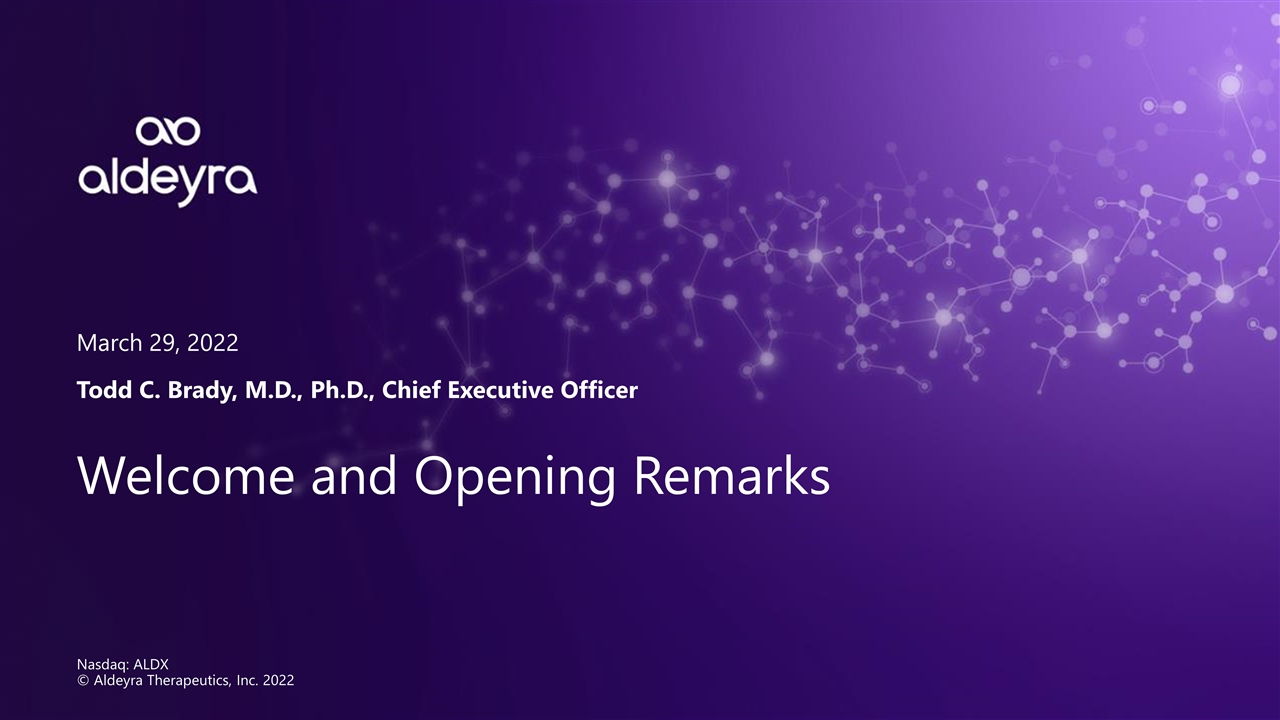
Welcome and Opening Remarks Todd C. Brady, M.D., Ph.D., Chief Executive Officer March 29, 2022 Nasdaq: ALDX © Aldeyra Therapeutics, Inc. 2022
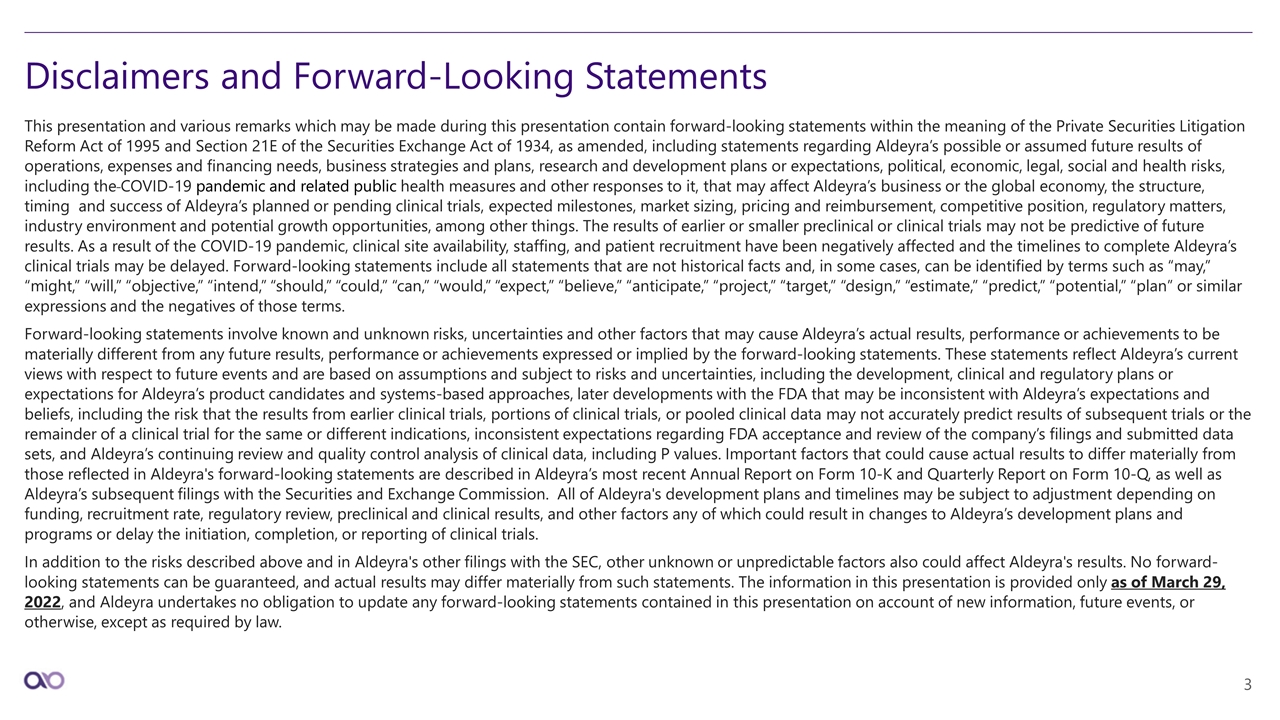
Disclaimers and Forward-Looking Statements This presentation and various remarks which may be made during this presentation contain forward-looking statements within the meaning of the Private Securities Litigation Reform Act of 1995 and Section 21E of the Securities Exchange Act of 1934, as amended, including statements regarding Aldeyra’s possible or assumed future results of operations, expenses and financing needs, business strategies and plans, research and development plans or expectations, political, economic, legal, social and health risks, including the COVID-19 pandemic and related public health measures and other responses to it, that may affect Aldeyra’s business or the global economy, the structure, timing and success of Aldeyra’s planned or pending clinical trials, expected milestones, market sizing, pricing and reimbursement, competitive position, regulatory matters, industry environment and potential growth opportunities, among other things. The results of earlier or smaller preclinical or clinical trials may not be predictive of future results. As a result of the COVID-19 pandemic, clinical site availability, staffing, and patient recruitment have been negatively affected and the timelines to complete Aldeyra’s clinical trials may be delayed. Forward-looking statements include all statements that are not historical facts and, in some cases, can be identified by terms such as “may,” “might,” “will,” “objective,” “intend,” “should,” “could,” “can,” “would,” “expect,” “believe,” “anticipate,” “project,” “target,” “design,” “estimate,” “predict,” “potential,” “plan” or similar expressions and the negatives of those terms. Forward-looking statements involve known and unknown risks, uncertainties and other factors that may cause Aldeyra’s actual results, performance or achievements to be materially different from any future results, performance or achievements expressed or implied by the forward-looking statements. These statements reflect Aldeyra’s current views with respect to future events and are based on assumptions and subject to risks and uncertainties, including the development, clinical and regulatory plans or expectations for Aldeyra’s product candidates and systems-based approaches, later developments with the FDA that may be inconsistent with Aldeyra’s expectations and beliefs, including the risk that the results from earlier clinical trials, portions of clinical trials, or pooled clinical data may not accurately predict results of subsequent trials or the remainder of a clinical trial for the same or different indications, inconsistent expectations regarding FDA acceptance and review of the company’s filings and submitted data sets, and Aldeyra’s continuing review and quality control analysis of clinical data, including P values. Important factors that could cause actual results to differ materially from those reflected in Aldeyra's forward-looking statements are described in Aldeyra’s most recent Annual Report on Form 10-K and Quarterly Report on Form 10-Q, as well as Aldeyra’s subsequent filings with the Securities and Exchange Commission. All of Aldeyra's development plans and timelines may be subject to adjustment depending on funding, recruitment rate, regulatory review, preclinical and clinical results, and other factors any of which could result in changes to Aldeyra’s development plans and programs or delay the initiation, completion, or reporting of clinical trials. In addition to the risks described above and in Aldeyra's other filings with the SEC, other unknown or unpredictable factors also could affect Aldeyra's results. No forward-looking statements can be guaranteed, and actual results may differ materially from such statements. The information in this presentation is provided only as of March 29, 2022, and Aldeyra undertakes no obligation to update any forward-looking statements contained in this presentation on account of new information, future events, or otherwise, except as required by law.
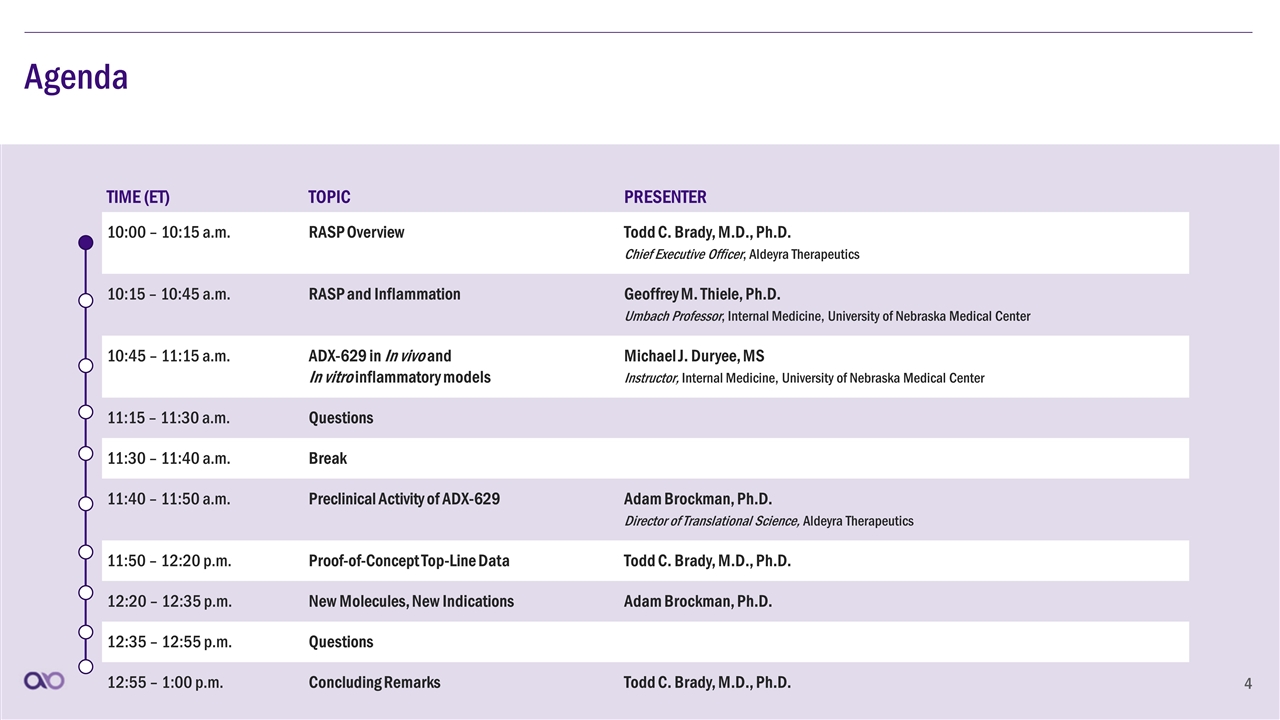
Agenda 4 TIME (ET) TOPIC PRESENTER 10:00 – 10:15 a.m. RASP Overview Todd C. Brady, M.D., Ph.D. Chief Executive Officer, Aldeyra Therapeutics 10:15 – 10:45 a.m. RASP and Inflammation Geoffrey M. Thiele, Ph.D. Umbach Professor, Internal Medicine, University of Nebraska Medical Center 10:45 – 11:15 a.m. ADX-629 in In vivo and In vitro inflammatory models Michael J. Duryee, MS Instructor, Internal Medicine, University of Nebraska Medical Center 11:15 – 11:30 a.m. Questions 11:30 – 11:40 a.m. Break 11:40 – 11:50 a.m. Preclinical Activity of ADX-629 Adam Brockman, Ph.D. Director of Translational Science, Aldeyra Therapeutics 11:50 – 12:20 p.m. Proof-of-Concept Top-Line Data Todd C. Brady, M.D., Ph.D. 12:20 – 12:35 p.m. New Molecules, New Indications Adam Brockman, Ph.D. 12:35 – 12:55 p.m. Questions 12:55 – 1:00 p.m. Concluding Remarks Todd C. Brady, M.D., Ph.D.
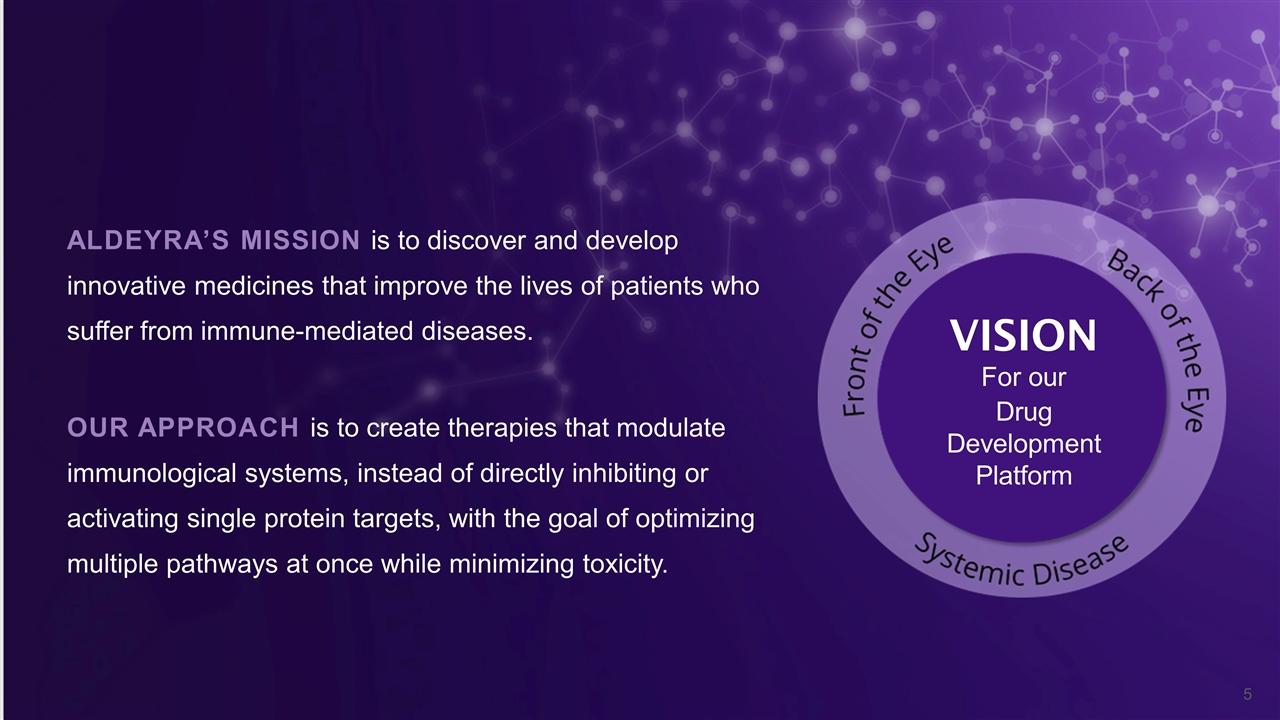
ALDEYRA’S MISSION is to discover and develop innovative medicines that improve the lives of patients who suffer from immune-mediated diseases. OUR APPROACH is to create therapies that modulate immunological systems, instead of directly inhibiting or activating single protein targets, with the goal of optimizing multiple pathways at once while minimizing toxicity. VISION For our Drug Development Platform
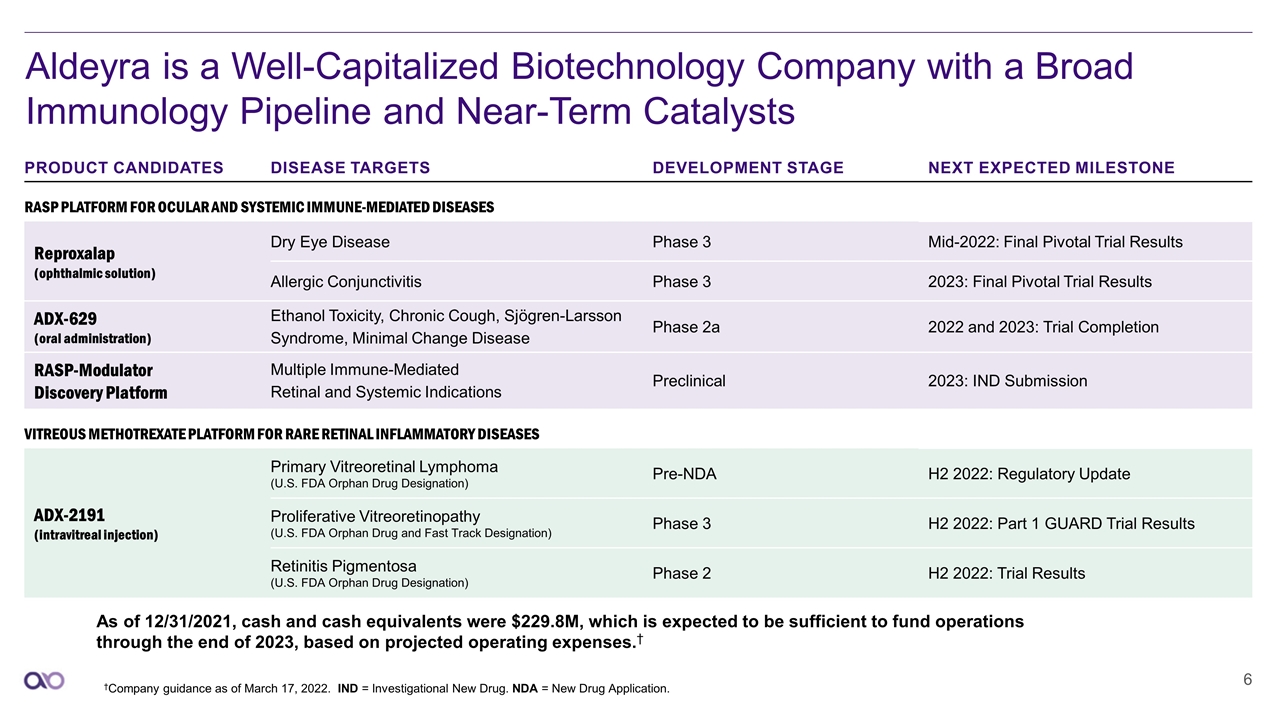
PRODUCT CANDIDATES DISEASE TARGETS DEVELOPMENT STAGE NEXT EXPECTED MILESTONE RASP PLATFORM FOR OCULAR AND SYSTEMIC IMMUNE-MEDIATED DISEASES Reproxalap (ophthalmic solution) Dry Eye Disease Phase 3 Mid-2022: Final Pivotal Trial Results Allergic Conjunctivitis Phase 3 2023: Final Pivotal Trial Results ADX-629 (oral administration) Ethanol Toxicity, Chronic Cough, Sjögren-Larsson Syndrome, Minimal Change Disease Phase 2a 2022 and 2023: Trial Completion RASP-Modulator Discovery Platform Multiple Immune-Mediated Retinal and Systemic Indications Preclinical 2023: IND Submission VITREOUS METHOTREXATE PLATFORM FOR RARE RETINAL INFLAMMATORY DISEASES ADX-2191 (intravitreal injection) Primary Vitreoretinal Lymphoma (U.S. FDA Orphan Drug Designation) Pre-NDA H2 2022: Regulatory Update Proliferative Vitreoretinopathy (U.S. FDA Orphan Drug and Fast Track Designation) Phase 3 H2 2022: Part 1 GUARD Trial Results Retinitis Pigmentosa (U.S. FDA Orphan Drug Designation) Phase 2 H2 2022: Trial Results Aldeyra is a Well-Capitalized Biotechnology Company with a Broad Immunology Pipeline and Near-Term Catalysts As of 12/31/2021, cash and cash equivalents were $229.8M, which is expected to be sufficient to fund operations through the end of 2023, based on projected operating expenses.† †Company guidance as of March 17, 2022. IND = Investigational New Drug. NDA = New Drug Application.
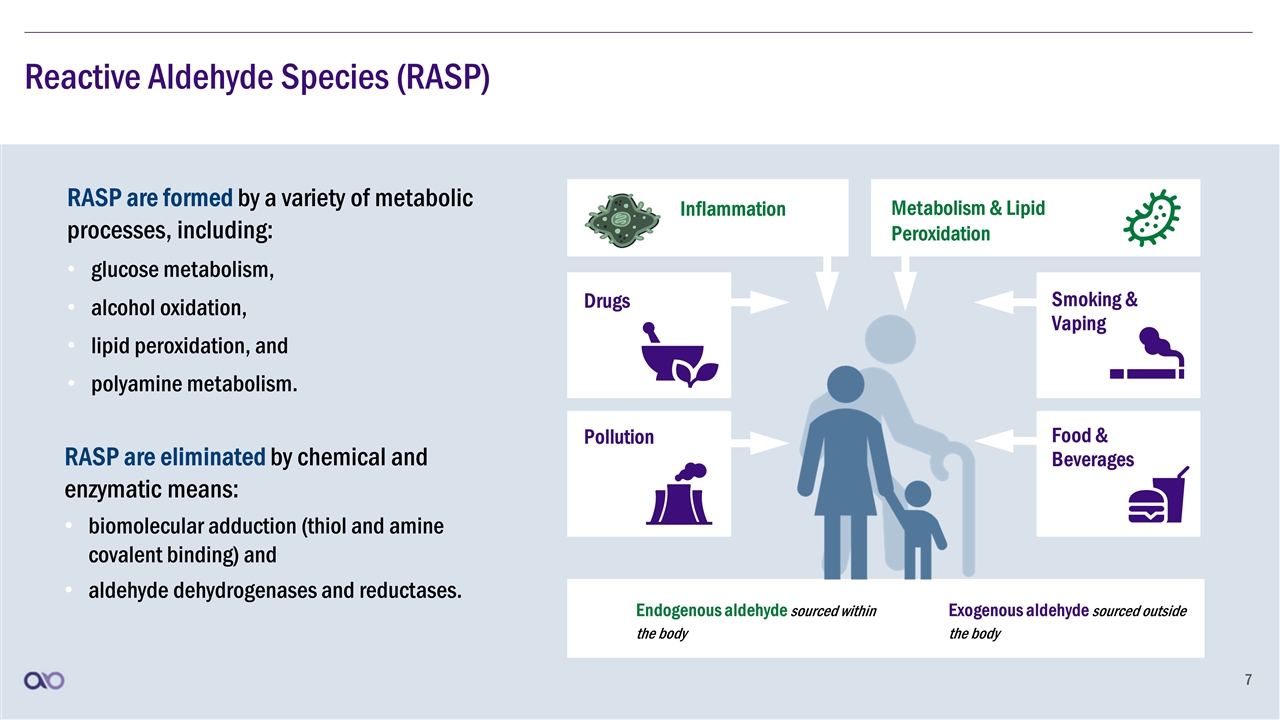
RASP are formed by a variety of metabolic processes, including: glucose metabolism, alcohol oxidation, lipid peroxidation, and polyamine metabolism. Reactive Aldehyde Species (RASP) RASP are eliminated by chemical and enzymatic means: biomolecular adduction (thiol and amine covalent binding) and aldehyde dehydrogenases and reductases. Drugs Metabolism & Lipid Peroxidation Smoking & Vaping Food & Beverages Pollution Endogenous aldehyde sourced within the body Inflammation Exogenous aldehyde sourced outside the body
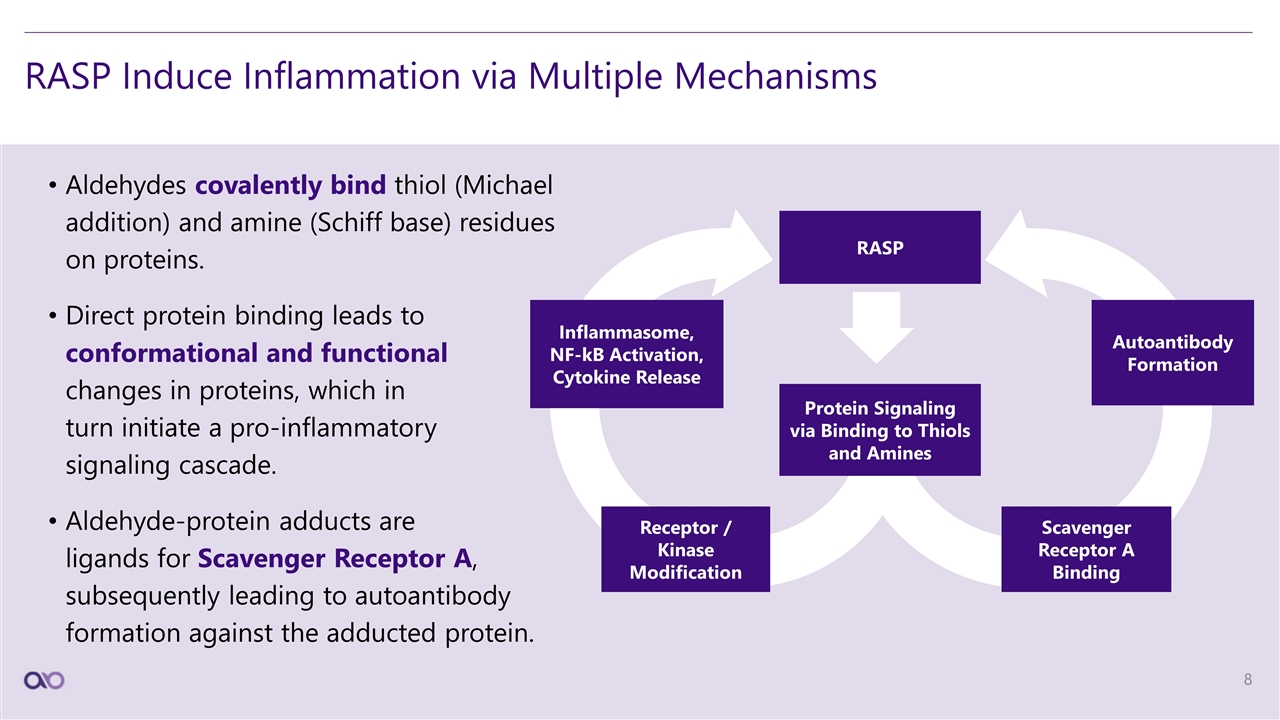
RASP Induce Inflammation via Multiple Mechanisms RASP Aldehydes covalently bind thiol (Michael addition) and amine (Schiff base) residues on proteins. Direct protein binding leads to conformational and functional changes in proteins, which in turn initiate a pro-inflammatory signaling cascade. Aldehyde-protein adducts are ligands for Scavenger Receptor A, subsequently leading to autoantibody formation against the adducted protein. Receptor / Kinase Modification Scavenger Receptor A Binding Protein Signaling via Binding to Thiols and Amines Inflammasome, NF-kB Activation, Cytokine Release Autoantibody Formation
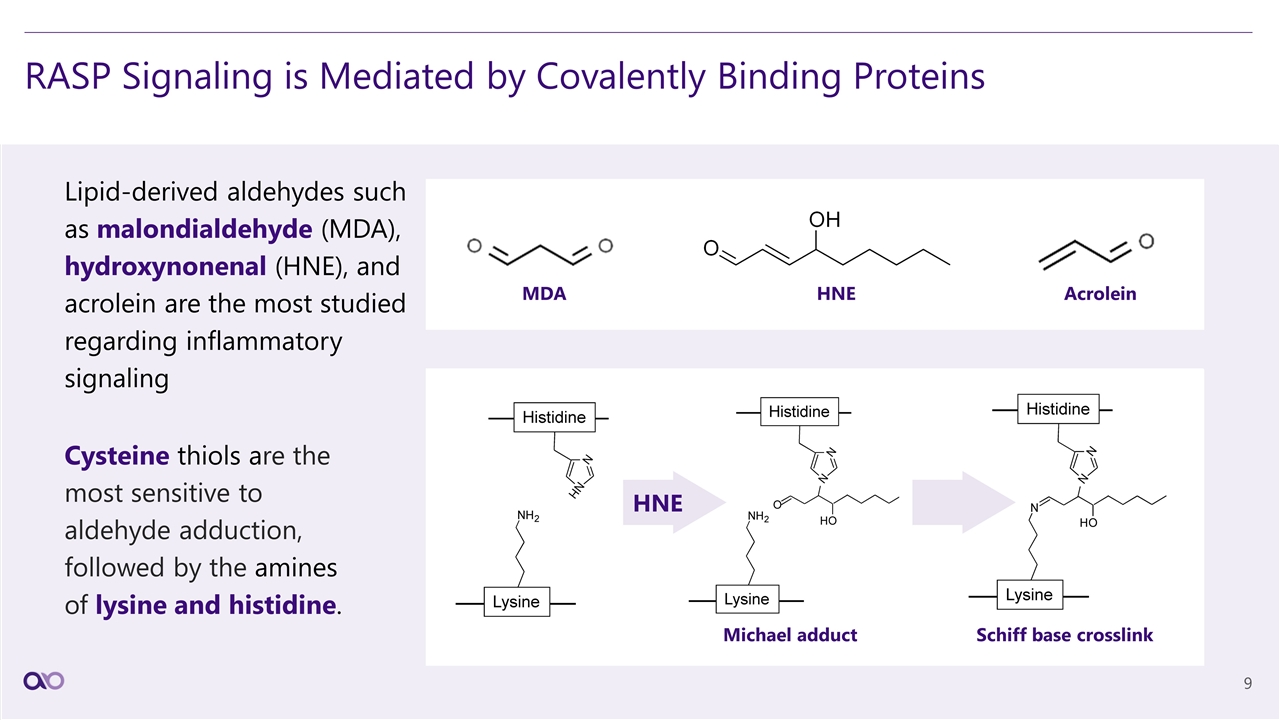
RASP Signaling is Mediated by Covalently Binding Proteins Lipid-derived aldehydes such as malondialdehyde (MDA), hydroxynonenal (HNE), and acrolein are the most studied regarding inflammatory signaling MDA HNE Acrolein Michael adduct Schiff base crosslink Cysteine thiols are the most sensitive to aldehyde adduction, followed by the amines of lysine and histidine. HNE
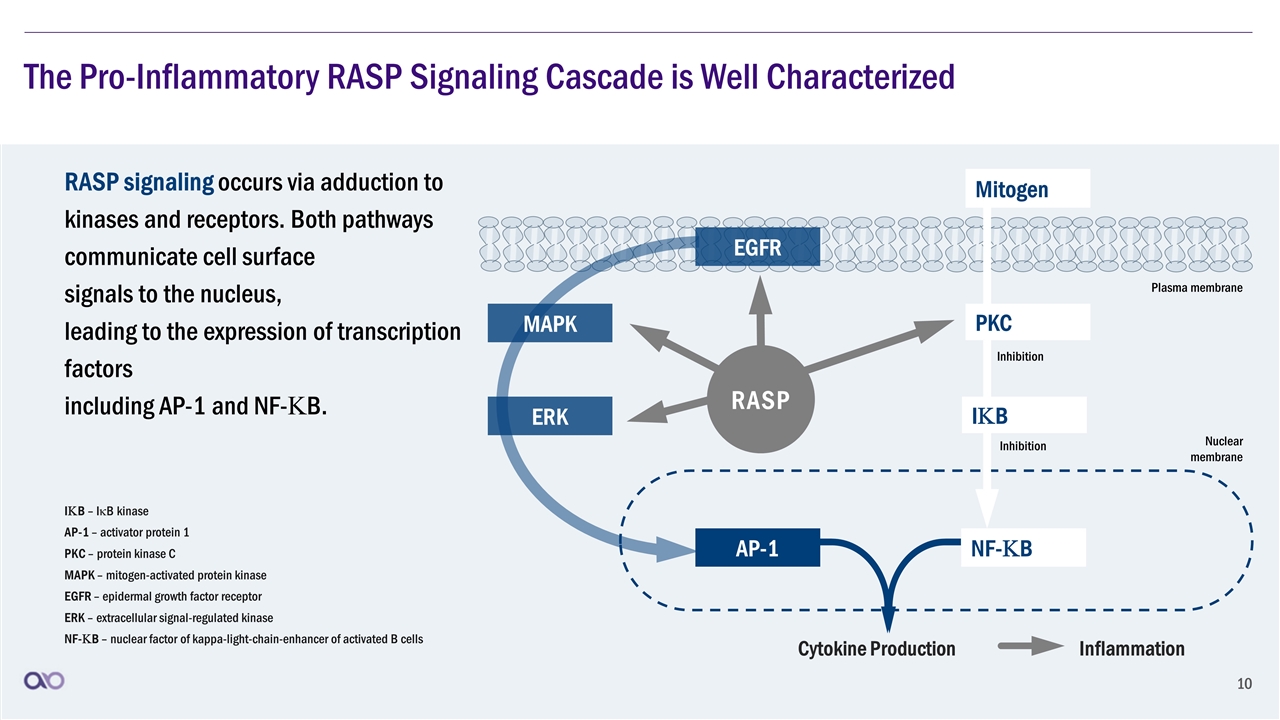
The Pro-Inflammatory RASP Signaling Cascade is Well Characterized RASP signaling occurs via adduction to kinases and receptors. Both pathways communicate cell surface signals to the nucleus, leading to the expression of transcription factors including AP-1 and NF-KB. IKB – IkB kinase AP-1 – activator protein 1 PKC – protein kinase C MAPK – mitogen-activated protein kinase EGFR – epidermal growth factor receptor ERK – extracellular signal-regulated kinase NF-KB – nuclear factor of kappa-light-chain-enhancer of activated B cells Cytokine Production NF-KB AP-1 Mitogen ERK MAPK EGFR Inflammation Plasma membrane Inhibition Inhibition IKB PKC RASP Nuclear membrane
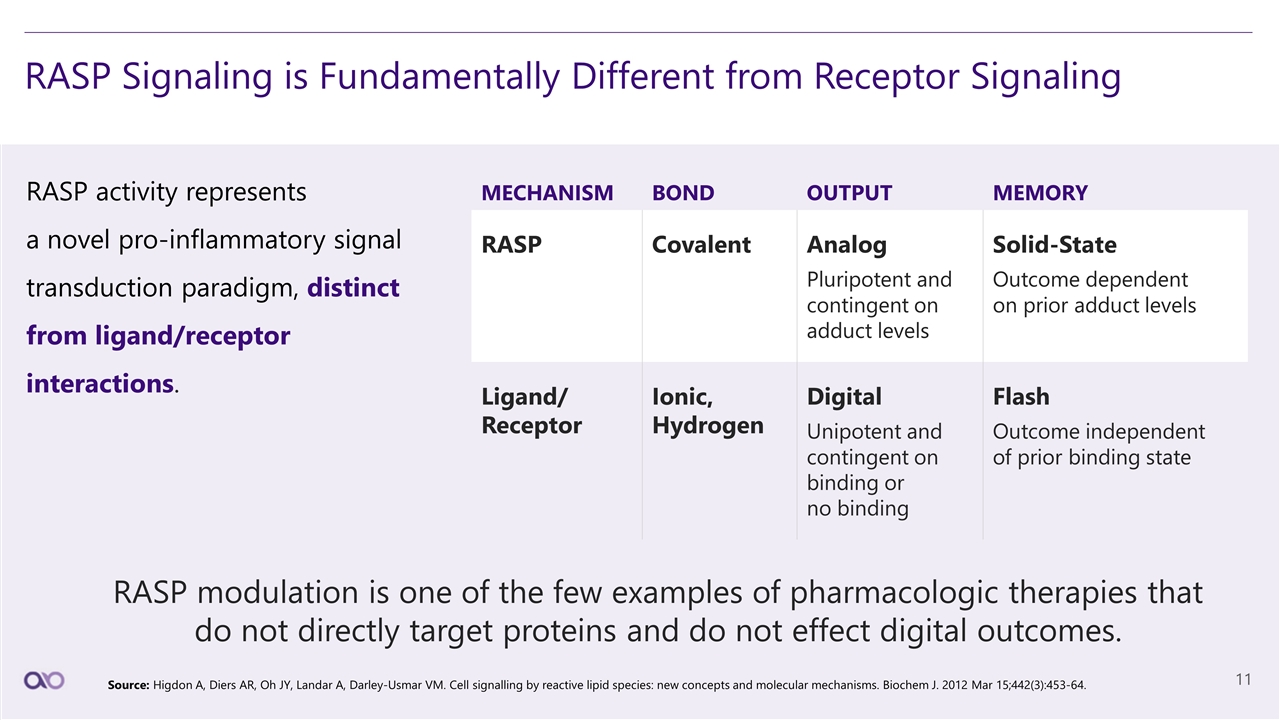
RASP Signaling is Fundamentally Different from Receptor Signaling RASP activity represents a novel pro-inflammatory signal transduction paradigm, distinct from ligand/receptor interactions. MECHANISM BOND OUTPUT MEMORY RASP Covalent Analog Pluripotent and contingent on adduct levels Solid-State Outcome dependent on prior adduct levels Ligand/ Receptor Ionic, Hydrogen Digital Unipotent and contingent on binding or no binding Flash Outcome independent of prior binding state RASP modulation is one of the few examples of pharmacologic therapies that do not directly target proteins and do not effect digital outcomes. Source: Higdon A, Diers AR, Oh JY, Landar A, Darley-Usmar VM. Cell signalling by reactive lipid species: new concepts and molecular mechanisms. Biochem J. 2012 Mar 15;442(3):453-64.
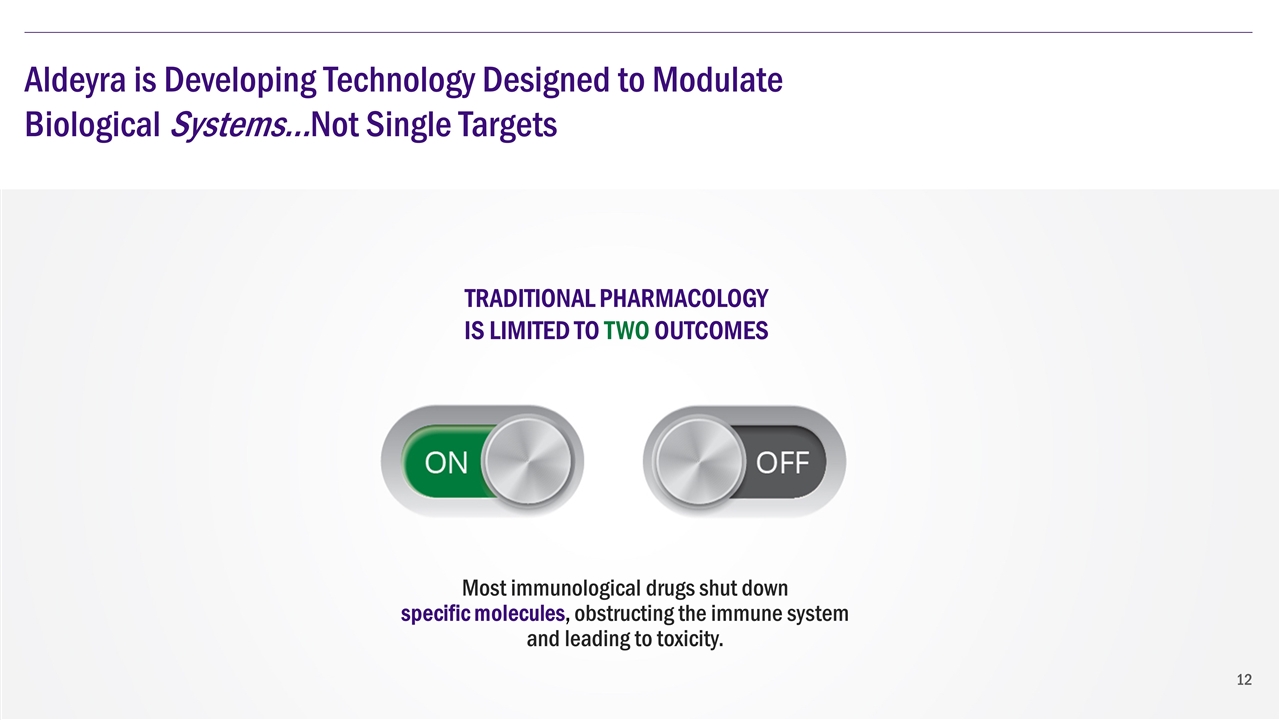
Aldeyra is Developing Technology Designed to Modulate Biological Systems…Not Single Targets TRADITIONAL PHARMACOLOGY IS LIMITED TO TWO OUTCOMES Most immunological drugs shut down specific molecules, obstructing the immune system and leading to toxicity.
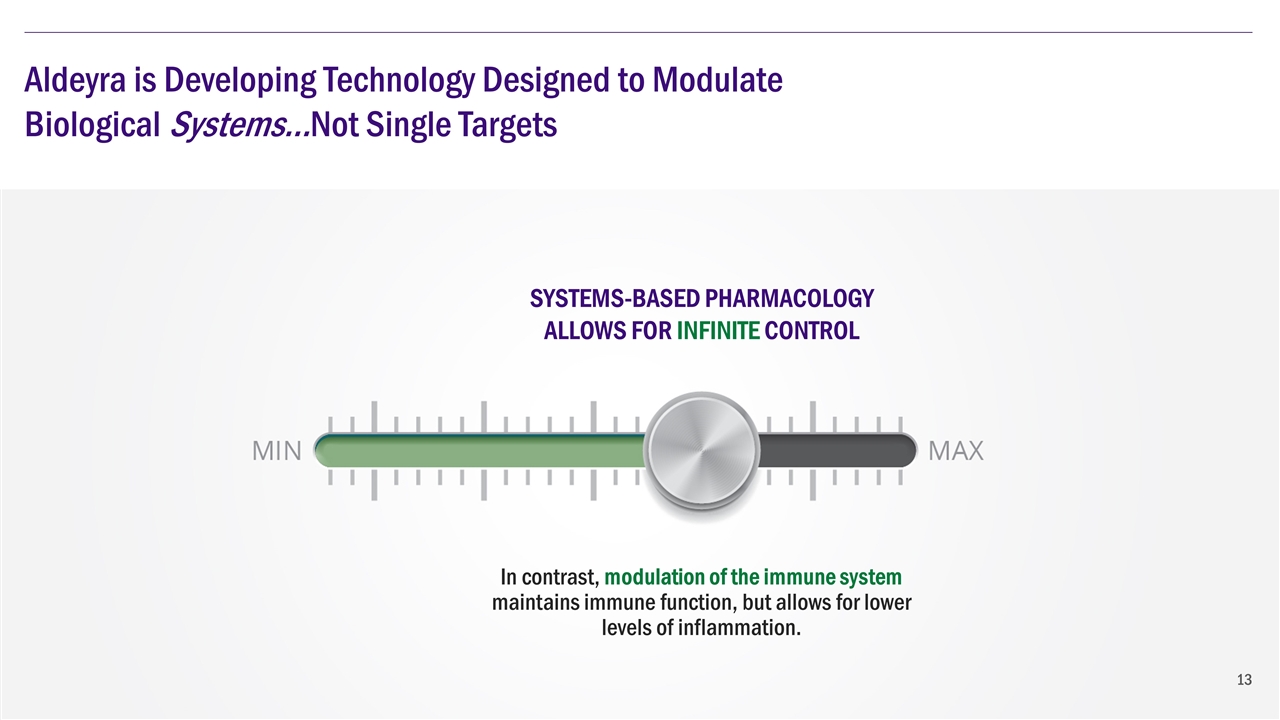
Aldeyra is Developing Technology Designed to Modulate Biological Systems…Not Single Targets SYSTEMS-BASED PHARMACOLOGY ALLOWS FOR INFINITE CONTROL In contrast, modulation of the immune system maintains immune function, but allows for lower levels of inflammation.
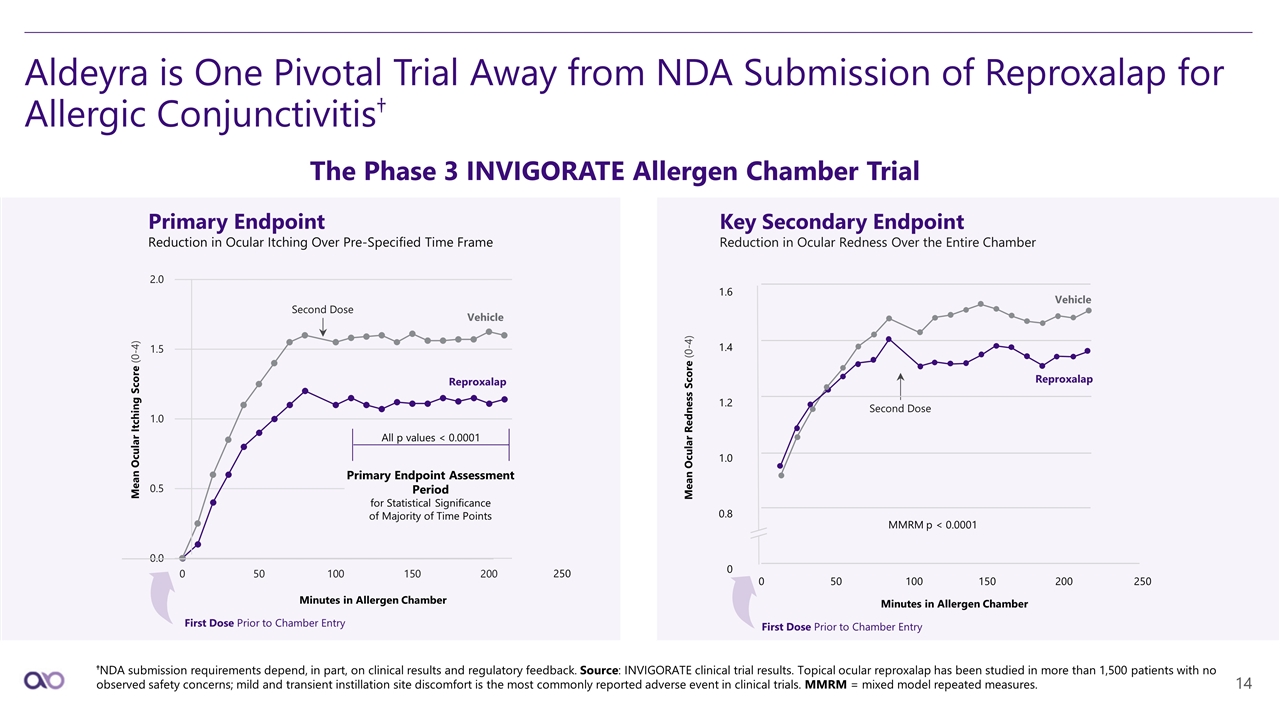
Aldeyra is One Pivotal Trial Away from NDA Submission of Reproxalap for Allergic Conjunctivitis† †NDA submission requirements depend, in part, on clinical results and regulatory feedback. Source: INVIGORATE clinical trial results. Topical ocular reproxalap has been studied in more than 1,500 patients with no observed safety concerns; mild and transient instillation site discomfort is the most commonly reported adverse event in clinical trials. MMRM = mixed model repeated measures. Minutes in Allergen Chamber First Dose Prior to Chamber Entry Key Secondary Endpoint Reduction in Ocular Redness Over the Entire Chamber Mean Ocular Redness Score (0-4) MMRM p < 0.0001 Second Dose Vehicle Reproxalap Minutes in Allergen Chamber Primary Endpoint Assessment Period for Statistical Significance of Majority of Time Points All p values < 0.0001 Second Dose First Dose Prior to Chamber Entry Primary Endpoint Reduction in Ocular Itching Over Pre-Specified Time Frame Mean Ocular Itching Score (0-4) Reproxalap Vehicle 250 1.6 1.4 1.2 1.0 0.8 0 050100150200250 The Phase 3 INVIGORATE Allergen Chamber Trial
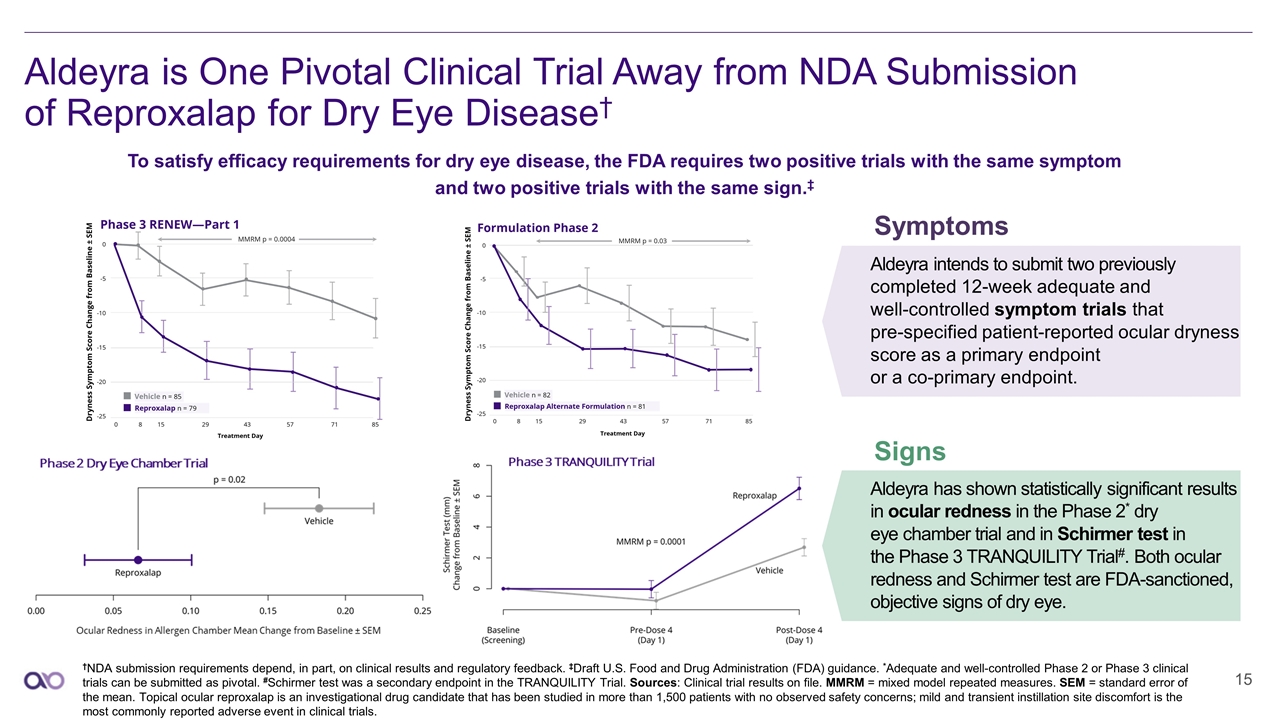
†NDA submission requirements depend, in part, on clinical results and regulatory feedback. ‡Draft U.S. Food and Drug Administration (FDA) guidance. *Adequate and well-controlled Phase 2 or Phase 3 clinical trials can be submitted as pivotal. #Schirmer test was a secondary endpoint in the TRANQUILITY Trial. Sources: Clinical trial results on file. MMRM = mixed model repeated measures. SEM = standard error of the mean. Topical ocular reproxalap is an investigational drug candidate that has been studied in more than 1,500 patients with no observed safety concerns; mild and transient instillation site discomfort is the most commonly reported adverse event in clinical trials. Aldeyra is One Pivotal Clinical Trial Away from NDA Submission of Reproxalap for Dry Eye Disease† Aldeyra intends to submit two previously completed 12-week adequate and well-controlled symptom trials that pre-specified patient-reported ocular dryness score as a primary endpoint or a co-primary endpoint. Symptoms Signs Aldeyra has shown statistically significant results in ocular redness in the Phase 2* dry eye chamber trial and in Schirmer test in the Phase 3 TRANQUILITY Trial#. Both ocular redness and Schirmer test are FDA-sanctioned, objective signs of dry eye. To satisfy efficacy requirements for dry eye disease, the FDA requires two positive trials with the same symptom and two positive trials with the same sign.‡
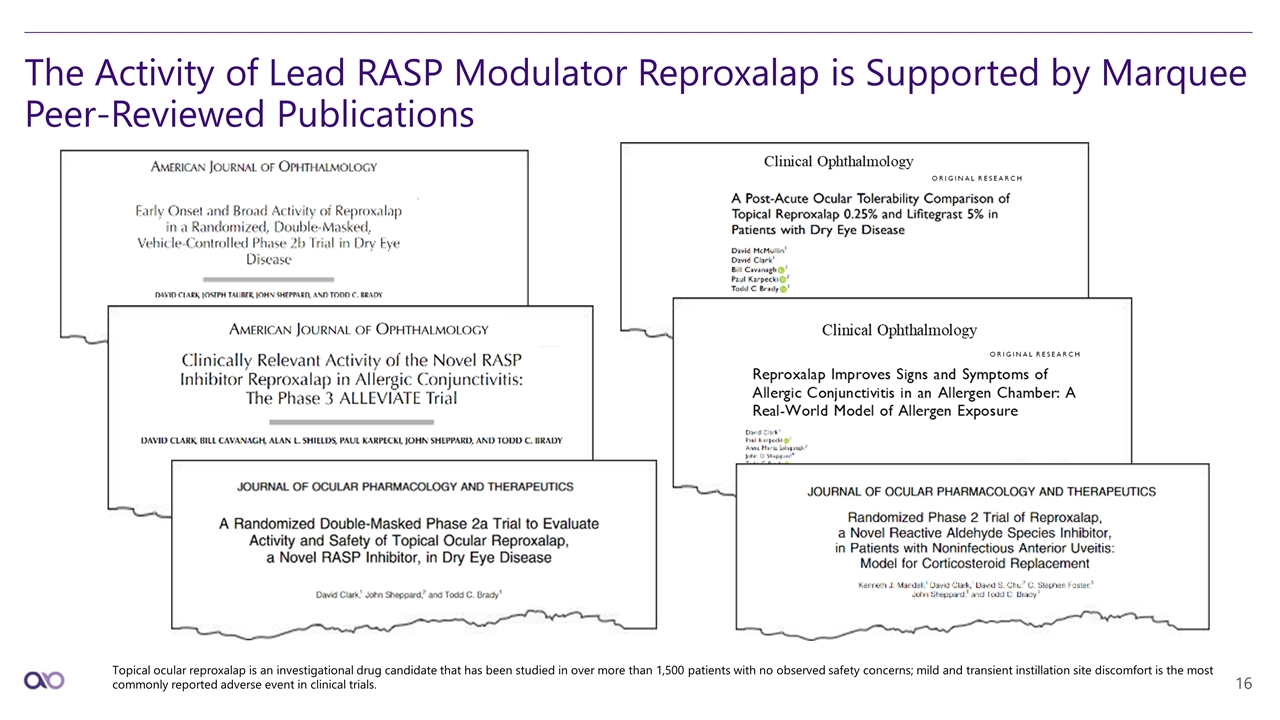
Topical ocular reproxalap is an investigational drug candidate that has been studied in over more than 1,500 patients with no observed safety concerns; mild and transient instillation site discomfort is the most commonly reported adverse event in clinical trials. The Activity of Lead RASP Modulator Reproxalap is Supported by Marquee Peer-Reviewed Publications

Reactive Aldehyde Species and Inflammation: Evidence for Malondialdehyde and Acetaldehyde as Pro-Inflammatory Mediators Geoffrey M. Thiele, Ph.D. Umbach Professor of Rheumatology Department of Internal Medicine Division of Rheumatology and Immunology
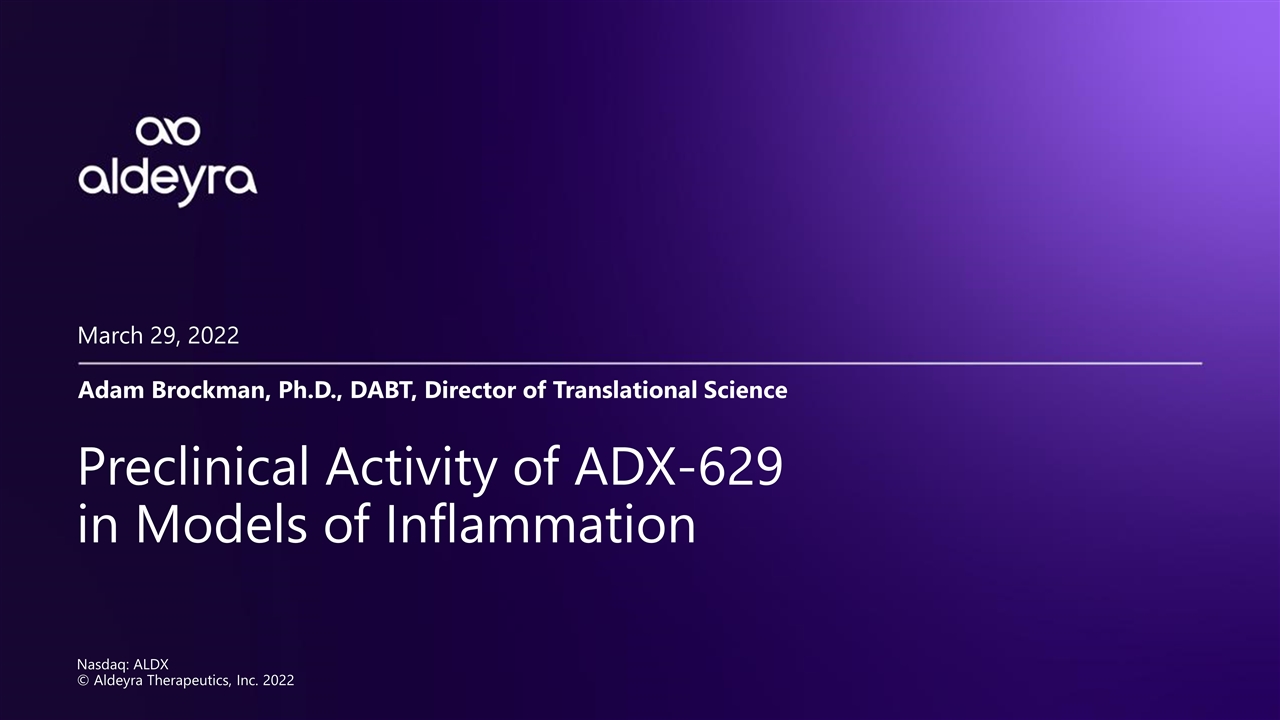
Adam Brockman, Ph.D., DABT, Director of Translational Science Preclinical Activity of ADX-629 in Models of Inflammation Nasdaq: ALDX © Aldeyra Therapeutics, Inc. 2022 March 29, 2022
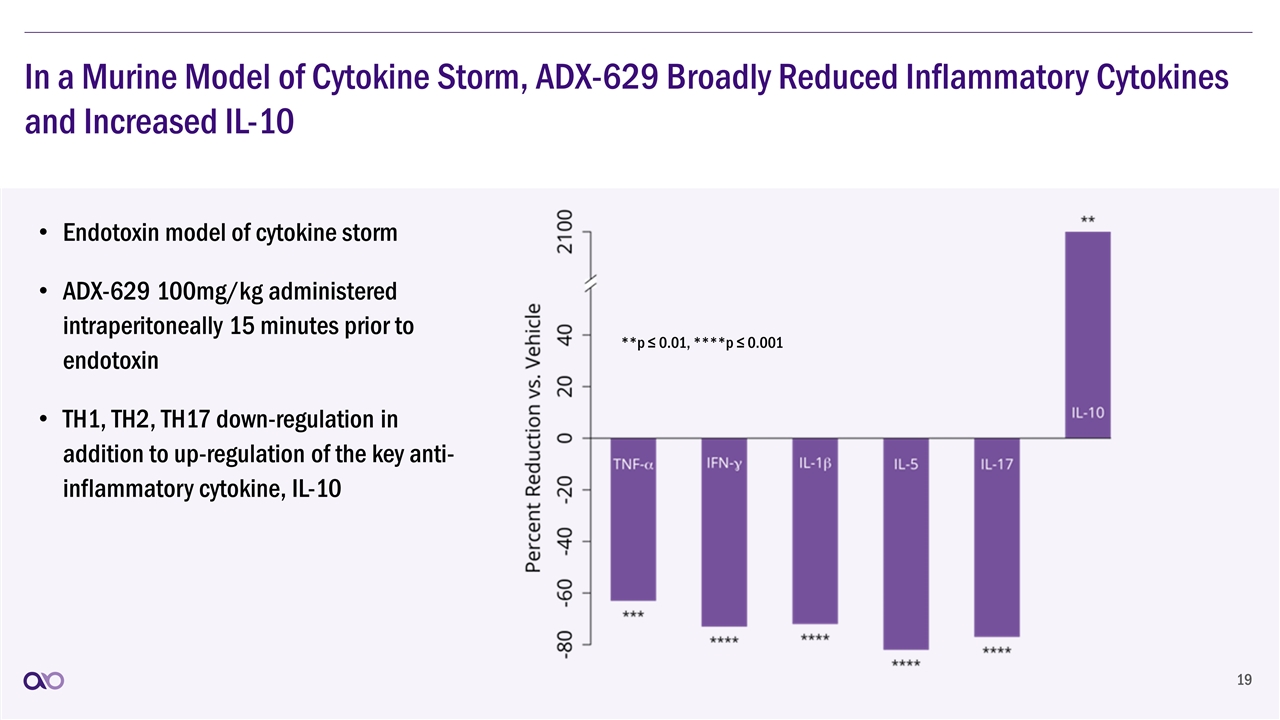
In a Murine Model of Cytokine Storm, ADX-629 Broadly Reduced Inflammatory Cytokines and Increased IL-10 Endotoxin model of cytokine storm ADX-629 100mg/kg administered intraperitoneally 15 minutes prior to endotoxin TH1, TH2, TH17 down-regulation in addition to up-regulation of the key anti-inflammatory cytokine, IL-10 **p ≤ 0.01, ****p ≤ 0.001
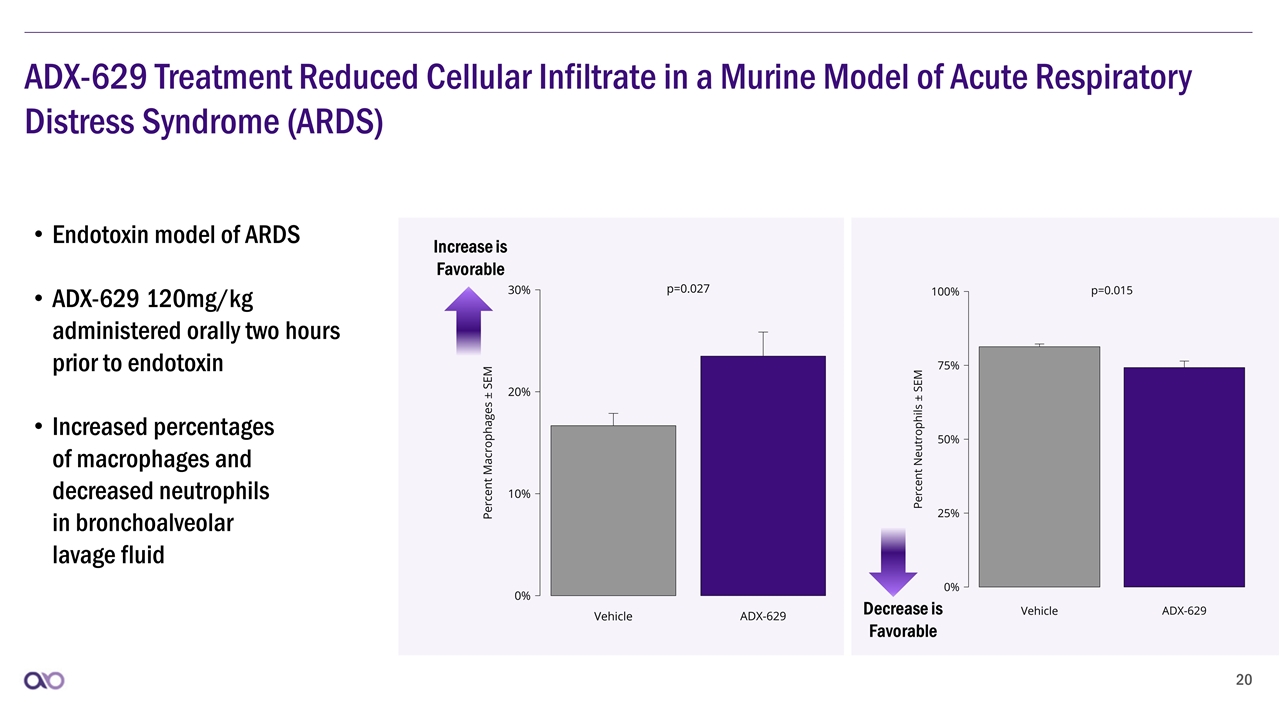
ADX-629 Treatment Reduced Cellular Infiltrate in a Murine Model of Acute Respiratory Distress Syndrome (ARDS) Endotoxin model of ARDS ADX-629 120mg/kg administered orally two hours prior to endotoxin Increased percentages of macrophages and decreased neutrophils in bronchoalveolar lavage fluid Increase is Favorable Decrease is Favorable
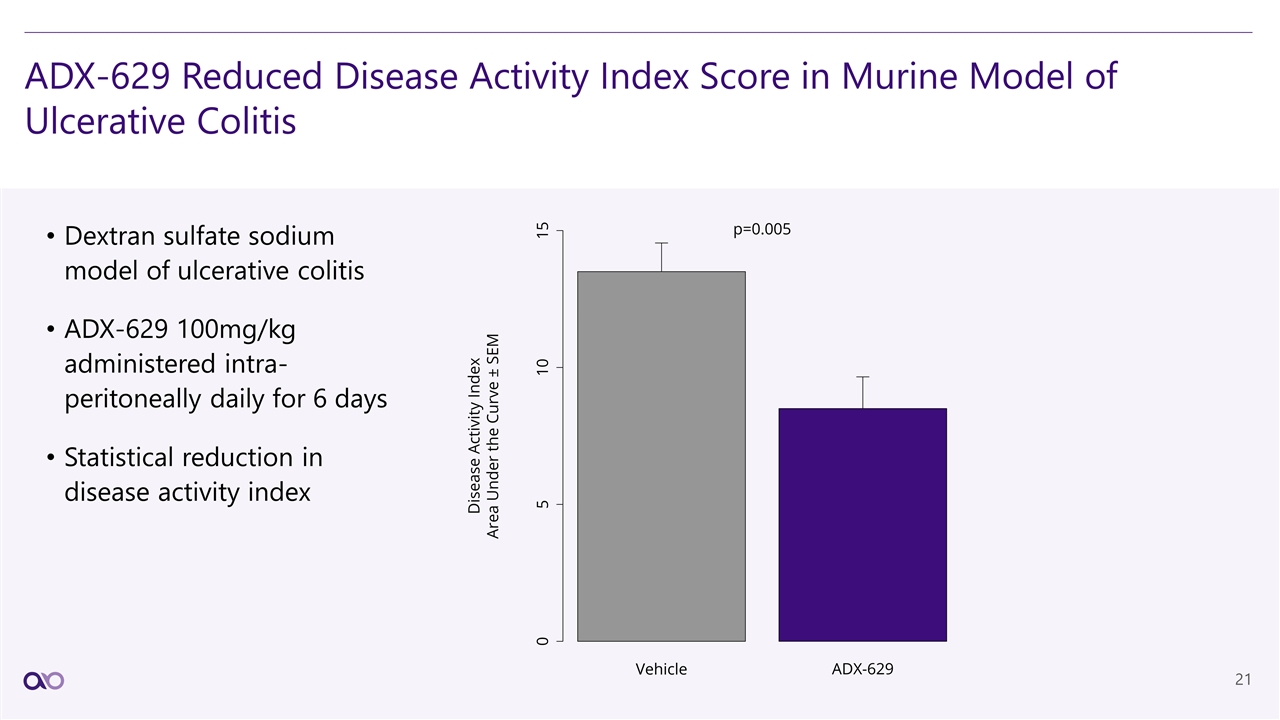
ADX-629 Reduced Disease Activity Index Score in Murine Model of Ulcerative Colitis Dextran sulfate sodium model of ulcerative colitis ADX-629 100mg/kg administered intra-peritoneally daily for 6 days Statistical reduction in disease activity index
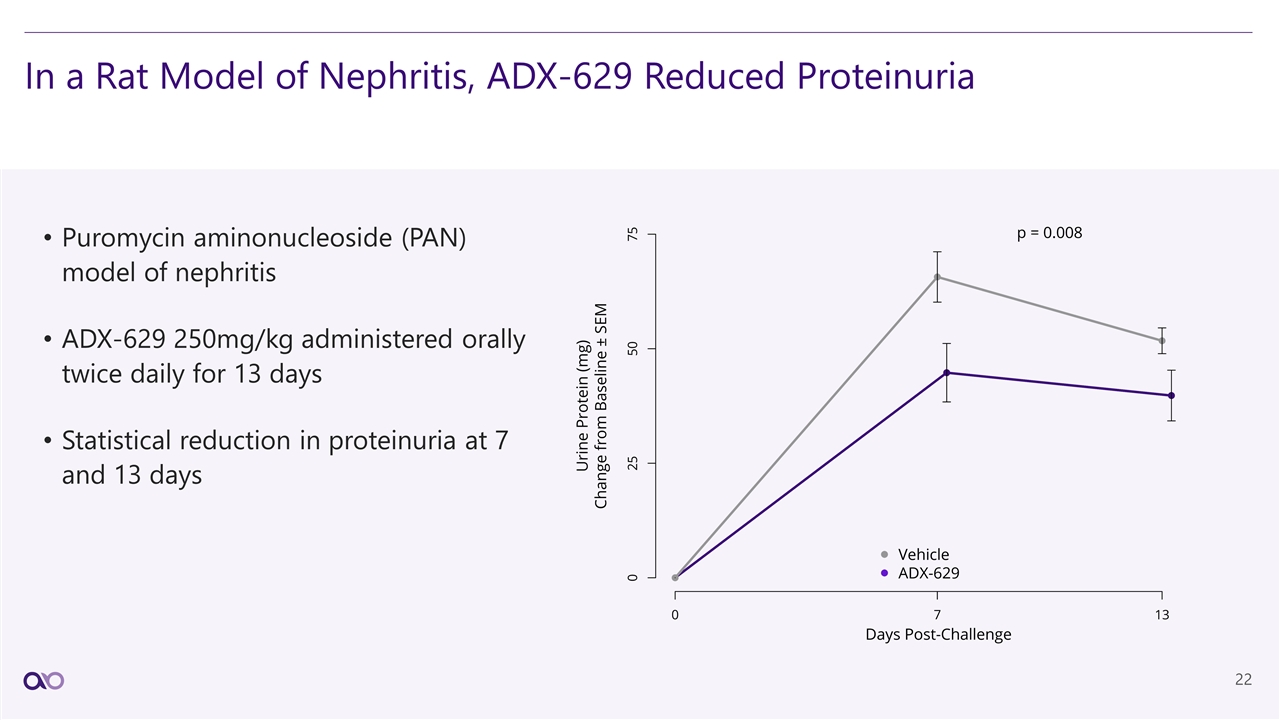
In a Rat Model of Nephritis, ADX-629 Reduced Proteinuria Puromycin aminonucleoside (PAN) model of nephritis ADX-629 250mg/kg administered orally twice daily for 13 days Statistical reduction in proteinuria at 7 and 13 days
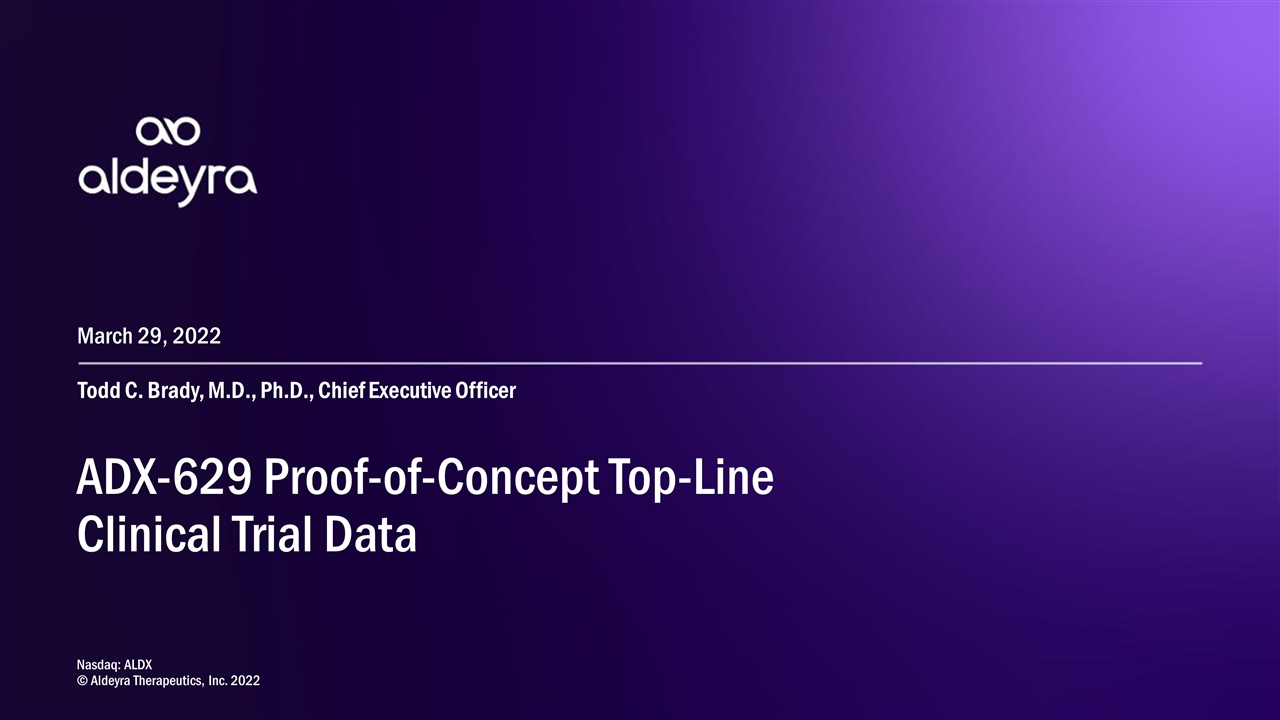
Todd C. Brady, M.D., Ph.D., Chief Executive Officer ADX-629 Proof-of-Concept Top-Line Clinical Trial Data Nasdaq: ALDX © Aldeyra Therapeutics, Inc. 2022 March 29, 2022
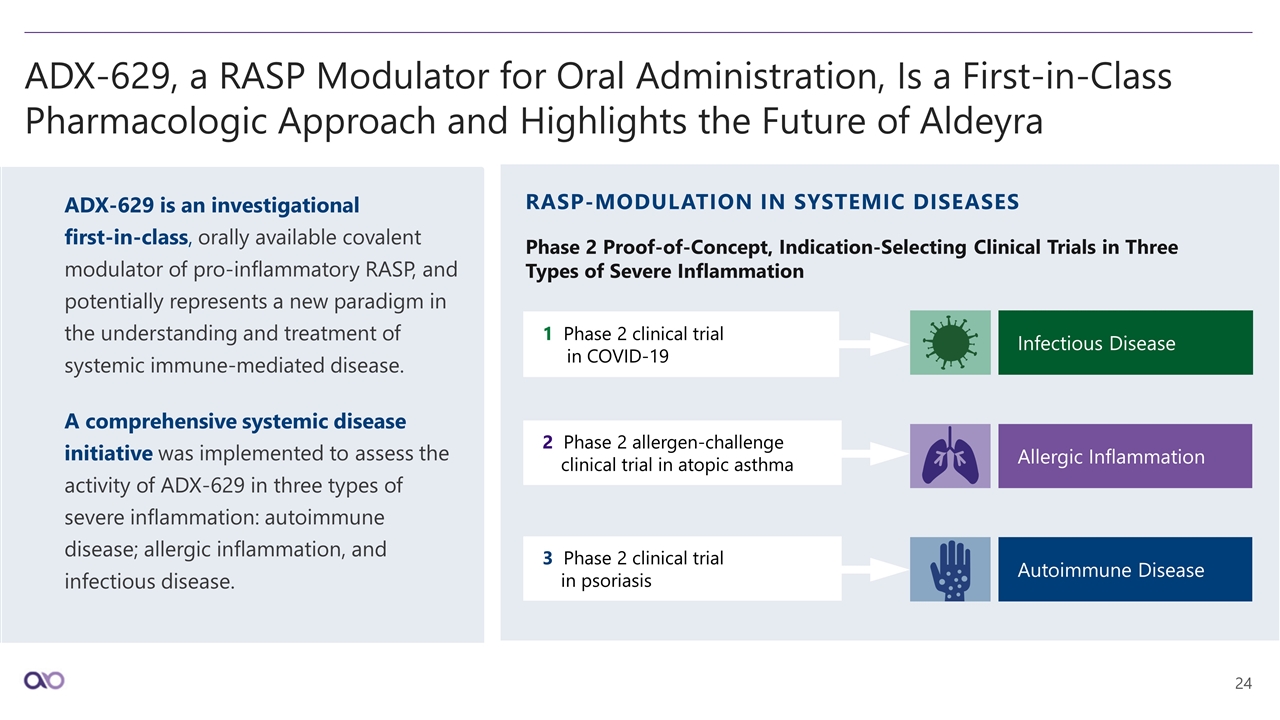
1 Phase 2 clinical trial in COVID-19 ADX-629, a RASP Modulator for Oral Administration, Is a First-in-Class Pharmacologic Approach and Highlights the Future of Aldeyra ADX-629 is an investigational first-in-class, orally available covalent modulator of pro-inflammatory RASP, and potentially represents a new paradigm in the understanding and treatment of systemic immune-mediated disease. A comprehensive systemic disease initiative was implemented to assess the activity of ADX-629 in three types of severe inflammation: autoimmune disease; allergic inflammation, and infectious disease. Phase 2 Proof-of-Concept, Indication-Selecting Clinical Trials in Three Types of Severe Inflammation RASP-MODULATION IN SYSTEMIC DISEASES Autoimmune Disease 2 Phase 2 allergen-challenge clinical trial in atopic asthma Allergic Inflammation Infectious Disease 3 Phase 2 clinical trial in psoriasis
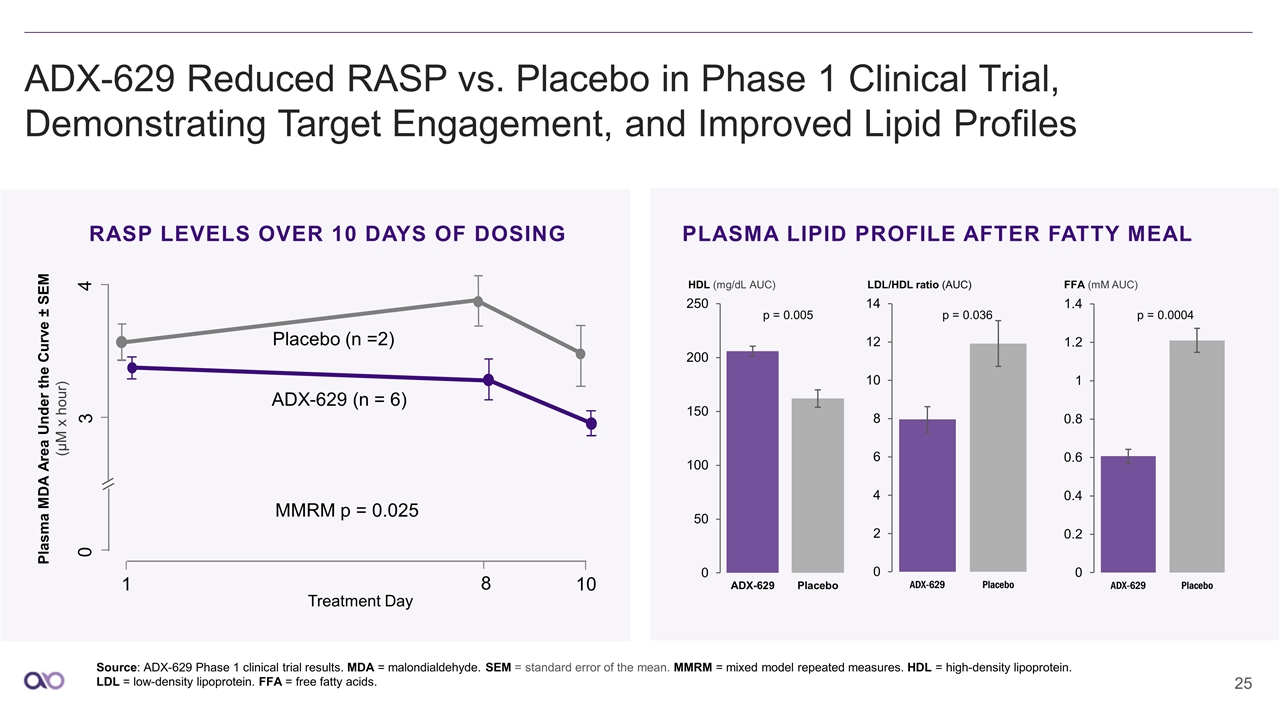
RASP LEVELS OVER 10 DAYS OF DOSING ADX-629 Reduced RASP vs. Placebo in Phase 1 Clinical Trial, Demonstrating Target Engagement, and Improved Lipid Profiles PLASMA LIPID PROFILE AFTER FATTY MEAL p = 0.005 p = 0.036 p = 0.0004 HDL (mg/dL AUC) LDL/HDL ratio (AUC) FFA (mM AUC) Source: ADX-629 Phase 1 clinical trial results. MDA = malondialdehyde. SEM = standard error of the mean. MMRM = mixed model repeated measures. HDL = high-density lipoprotein. LDL = low-density lipoprotein. FFA = free fatty acids. Plasma MDA Area Under the Curve ± SEM (µM x hour) 0 3 4 1 8 10 Placebo (n =2) ADX-629 (n = 6) MMRM p = 0.025 Treatment Day
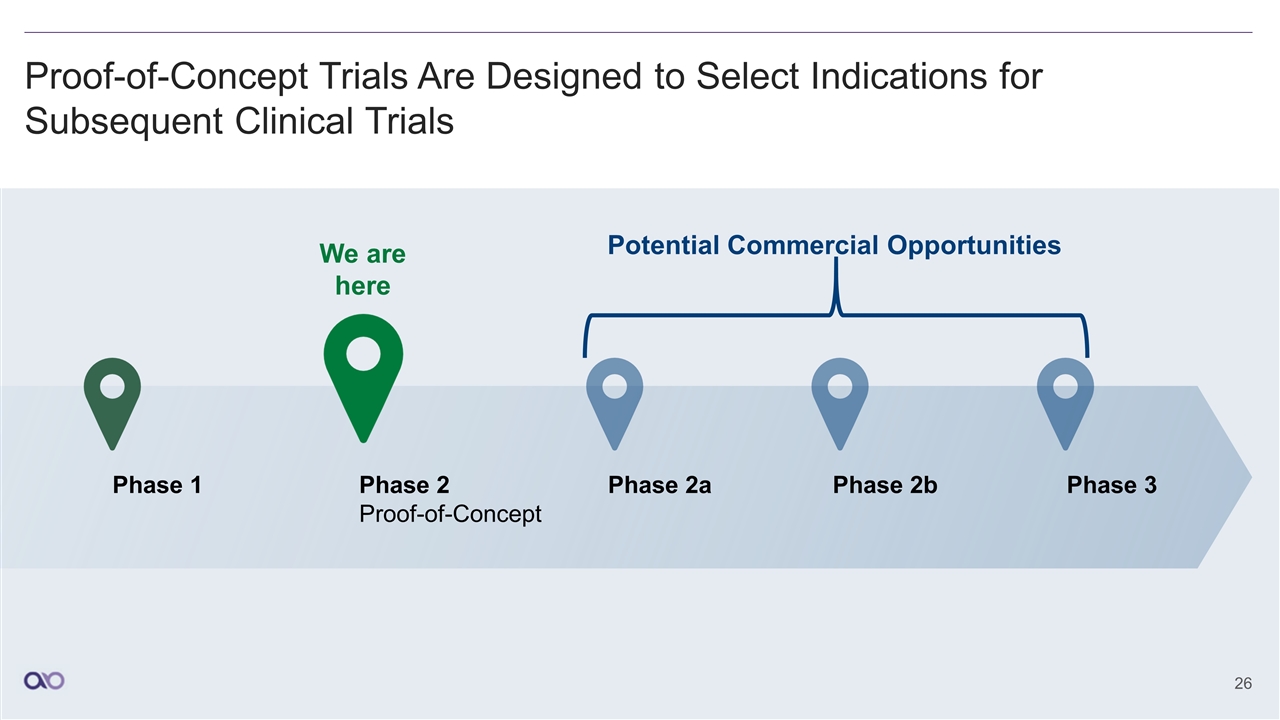
Proof-of-Concept Trials Are Designed to Select Indications for Subsequent Clinical Trials Phase 1 Phase 2 Proof-of-Concept Phase 2a Phase 2b Phase 3 We are here Potential Commercial Opportunities

A Phase 2 Proof-of-Concept Safety, Tolerability, and Activity Trial of ADX-629 in Patients with Mild to Moderate COVID-19 DESIGN Multi-center, randomized, double-masked, parallel-group, placebo-controlled DOSING 300mg ADX-629 or placebo twice-daily for 28 days 2:1 randomization PATIENTS 11 (4 placebo, 7 ADX-629) Mild to moderate COVID-19, not on supplemental oxygen ENDPOINTS Clinical: Supplemental oxygen use, hospitalization, mechanical ventilation, intensive care unit admission, death, National Institute of Allergy and Infectious Diseases (NIAID) score Pharmacodynamic: Plasma cytokine, RASP levels Infectious Disease: COVID-19
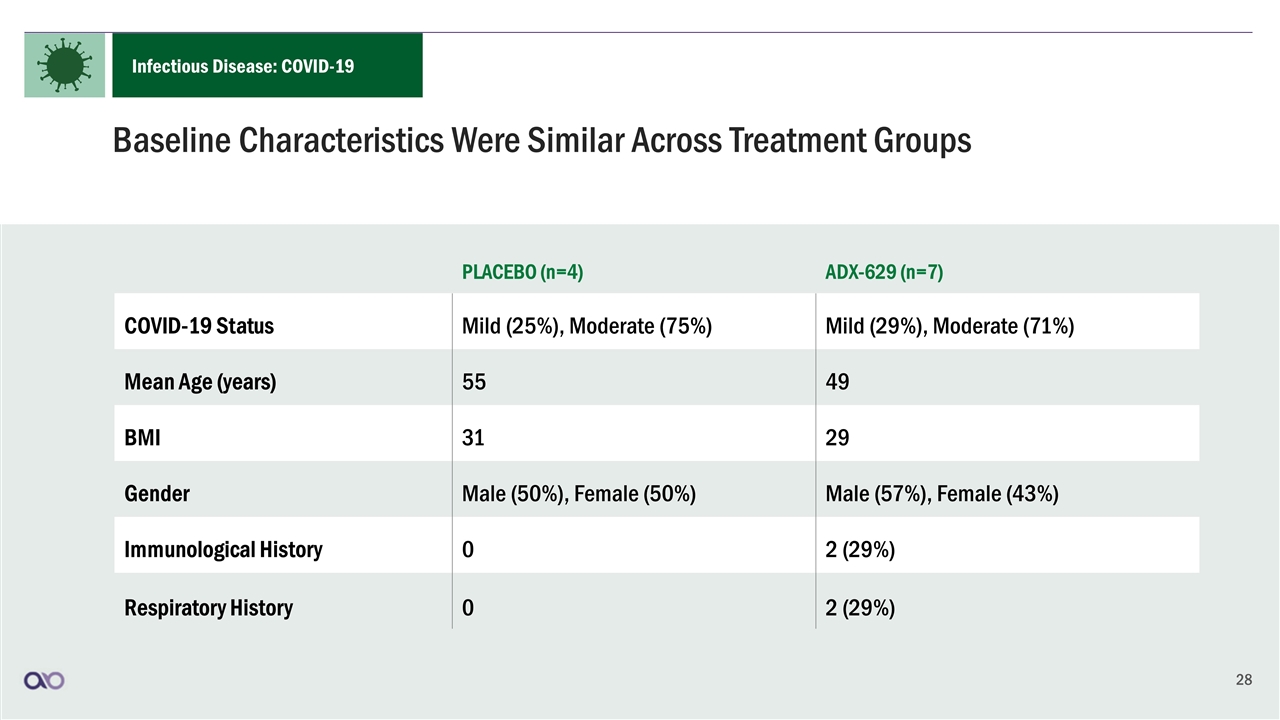
Baseline Characteristics Were Similar Across Treatment Groups PLACEBO (n=4) ADX-629 (n=7) COVID-19 Status Mild (25%), Moderate (75%) Mild (29%), Moderate (71%) Mean Age (years) 55 49 BMI 31 29 Gender Male (50%), Female (50%) Male (57%), Female (43%) Immunological History 0 2 (29%) Respiratory History 0 2 (29%) Infectious Disease: COVID-19
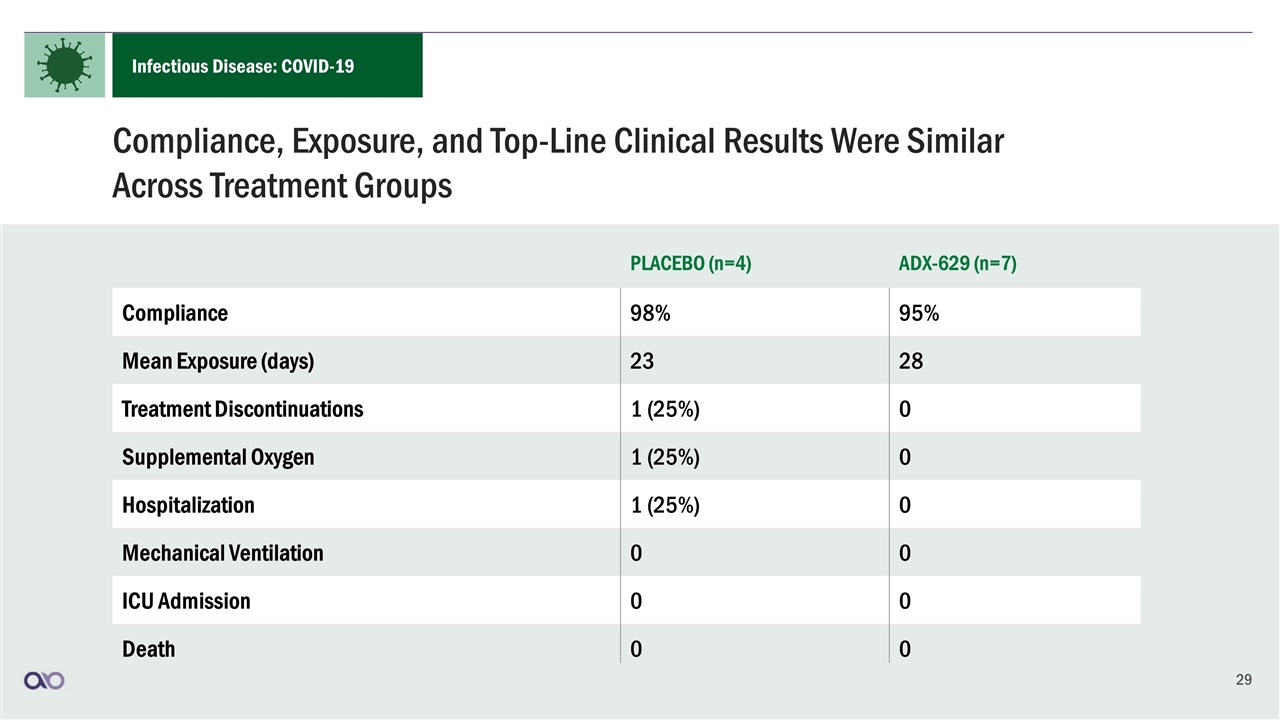
Compliance, Exposure, and Top-Line Clinical Results Were Similar Across Treatment Groups PLACEBO (n=4) ADX-629 (n=7) Compliance 98% 95% Mean Exposure (days) 23 28 Treatment Discontinuations 1 (25%) 0 Supplemental Oxygen 1 (25%) 0 Hospitalization 1 (25%) 0 Mechanical Ventilation 0 0 ICU Admission 0 0 Death 0 0 Infectious Disease: COVID-19
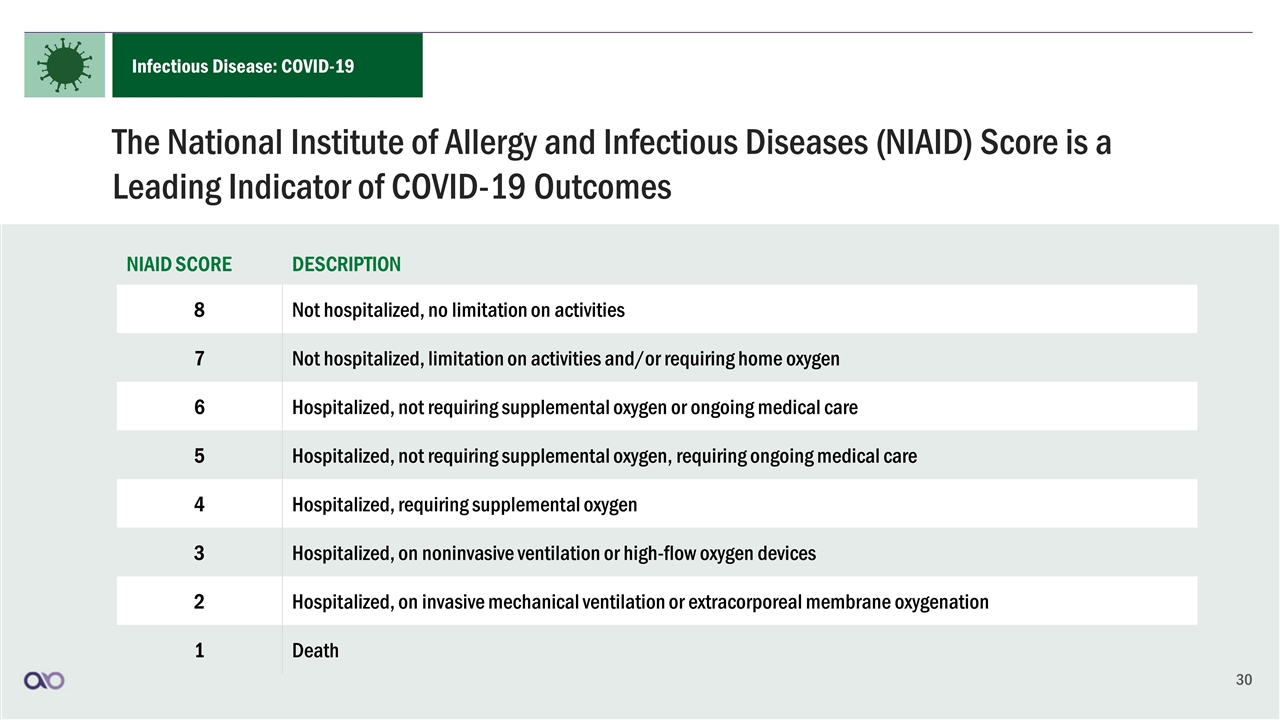
The National Institute of Allergy and Infectious Diseases (NIAID) Score is a Leading Indicator of COVID-19 Outcomes NIAID SCORE DESCRIPTION 8 Not hospitalized, no limitation on activities 7 Not hospitalized, limitation on activities and/or requiring home oxygen 6 Hospitalized, not requiring supplemental oxygen or ongoing medical care 5 Hospitalized, not requiring supplemental oxygen, requiring ongoing medical care 4 Hospitalized, requiring supplemental oxygen 3 Hospitalized, on noninvasive ventilation or high-flow oxygen devices 2 Hospitalized, on invasive mechanical ventilation or extracorporeal membrane oxygenation 1 Death Infectious Disease: COVID-19
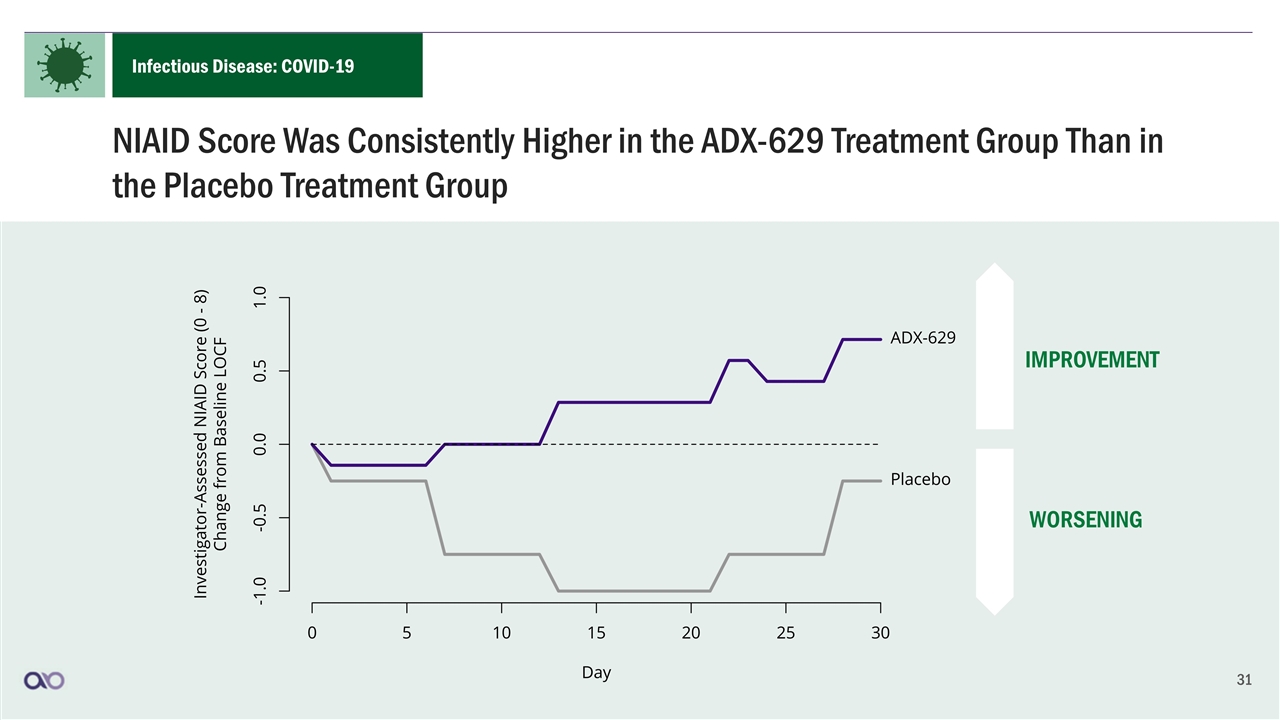
NIAID Score Was Consistently Higher in the ADX-629 Treatment Group Than in the Placebo Treatment Group IMPROVEMENT WORSENING Infectious Disease: COVID-19
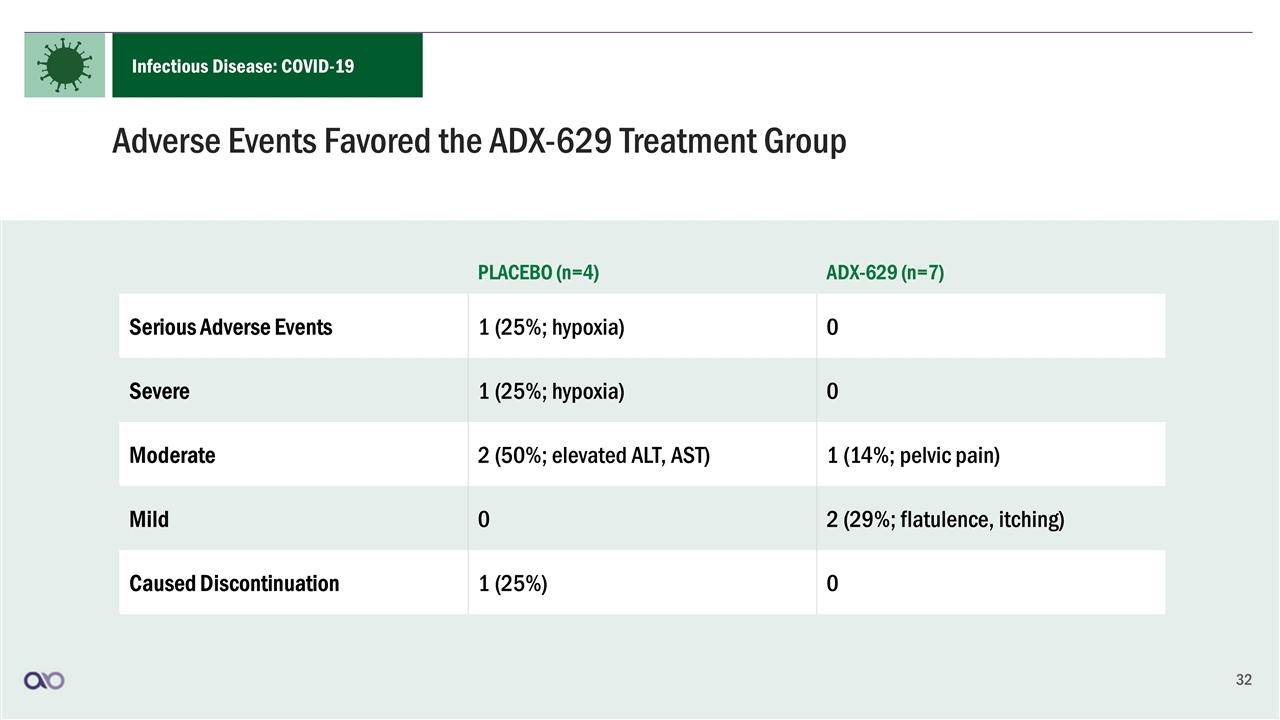
Adverse Events Favored the ADX-629 Treatment Group PLACEBO (n=4) ADX-629 (n=7) Serious Adverse Events 1 (25%; hypoxia) 0 Severe 1 (25%; hypoxia) 0 Moderate 2 (50%; elevated ALT, AST) 1 (14%; pelvic pain) Mild 0 2 (29%; flatulence, itching) Caused Discontinuation 1 (25%) 0 Infectious Disease: COVID-19
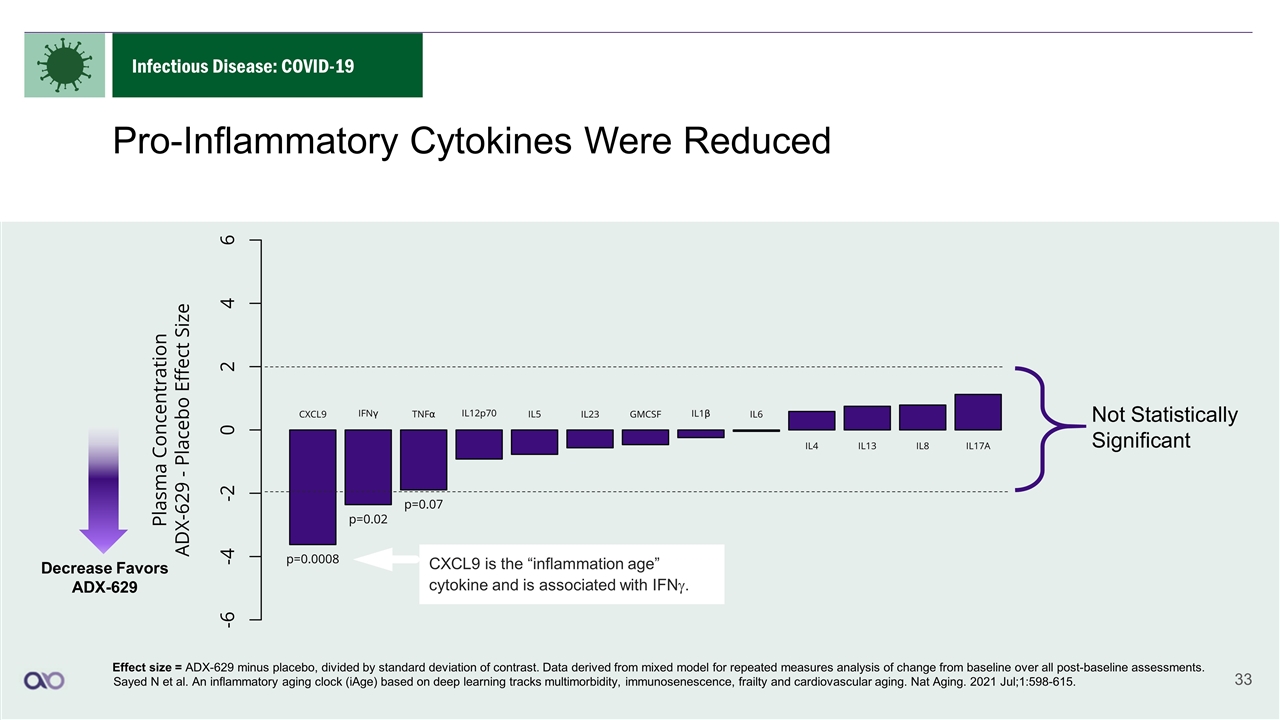
33 Not Statistically Significant Effect size = ADX-629 minus placebo, divided by standard deviation of contrast. Data derived from mixed model for repeated measures analysis of change from baseline over all post-baseline assessments. Sayed N et al. An inflammatory aging clock (iAge) based on deep learning tracks multimorbidity, immunosenescence, frailty and cardiovascular aging. Nat Aging. 2021 Jul;1:598-615. Pro-Inflammatory Cytokines Were Reduced Infectious Disease: COVID-19 CXCL9 is the “inflammation age” cytokine and is associated with IFNg. Decrease Favors ADX-629
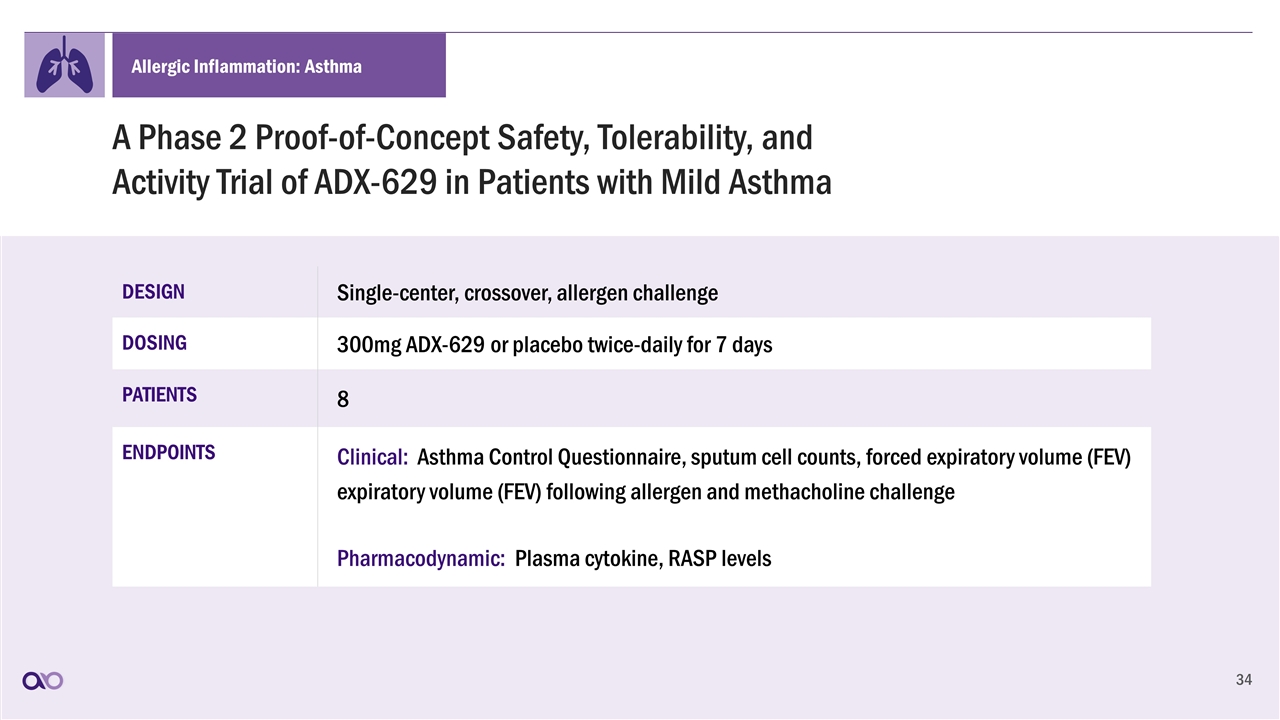
A Phase 2 Proof-of-Concept Safety, Tolerability, and Activity Trial of ADX-629 in Patients with Mild Asthma DESIGN Single-center, crossover, allergen challenge DOSING 300mg ADX-629 or placebo twice-daily for 7 days PATIENTS 8 ENDPOINTS Clinical: Asthma Control Questionnaire, sputum cell counts, forced expiratory volume (FEV) following allergen and methacholine challenge Pharmacodynamic: Plasma cytokine, RASP levels Allergic Inflammation: Asthma
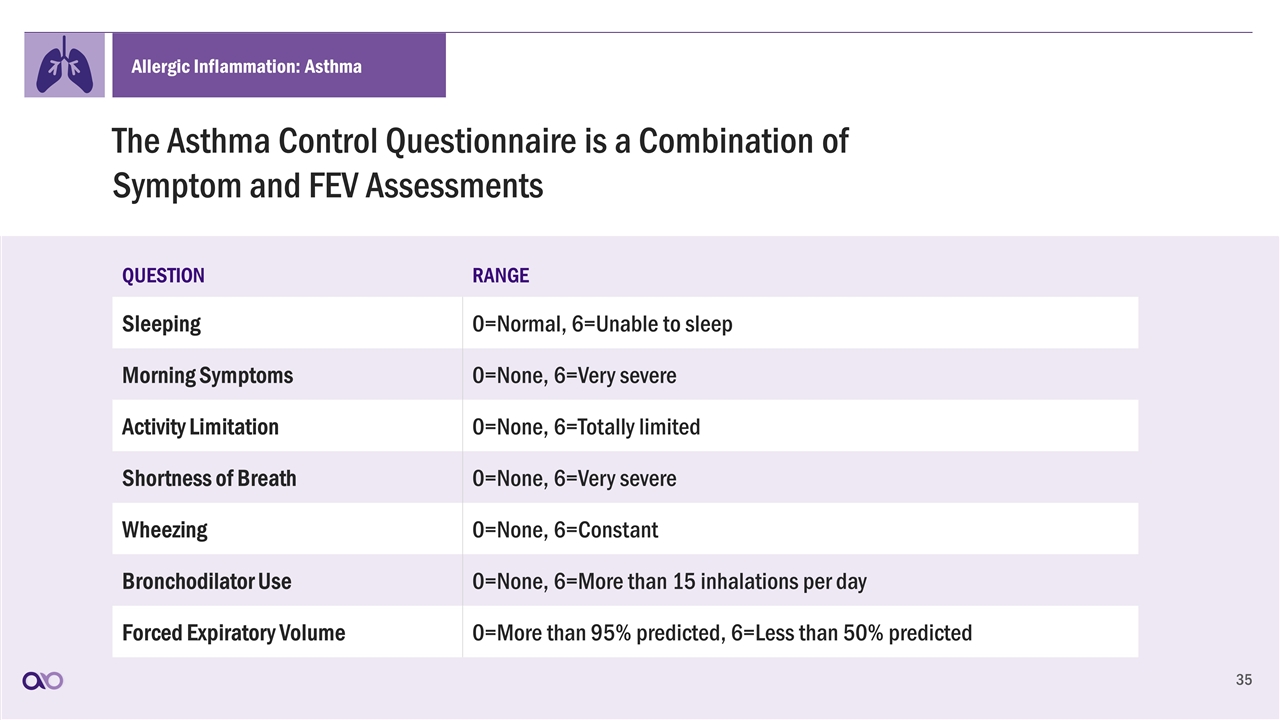
The Asthma Control Questionnaire is a Combination of Symptom and FEV Assessments QUESTION RANGE Sleeping 0=Normal, 6=Unable to sleep Morning Symptoms 0=None, 6=Very severe Activity Limitation 0=None, 6=Totally limited Shortness of Breath 0=None, 6=Very severe Wheezing 0=None, 6=Constant Bronchodilator Use 0=None, 6=More than 15 inhalations per day Forced Expiratory Volume 0=More than 95% predicted, 6=Less than 50% predicted Allergic Inflammation: Asthma
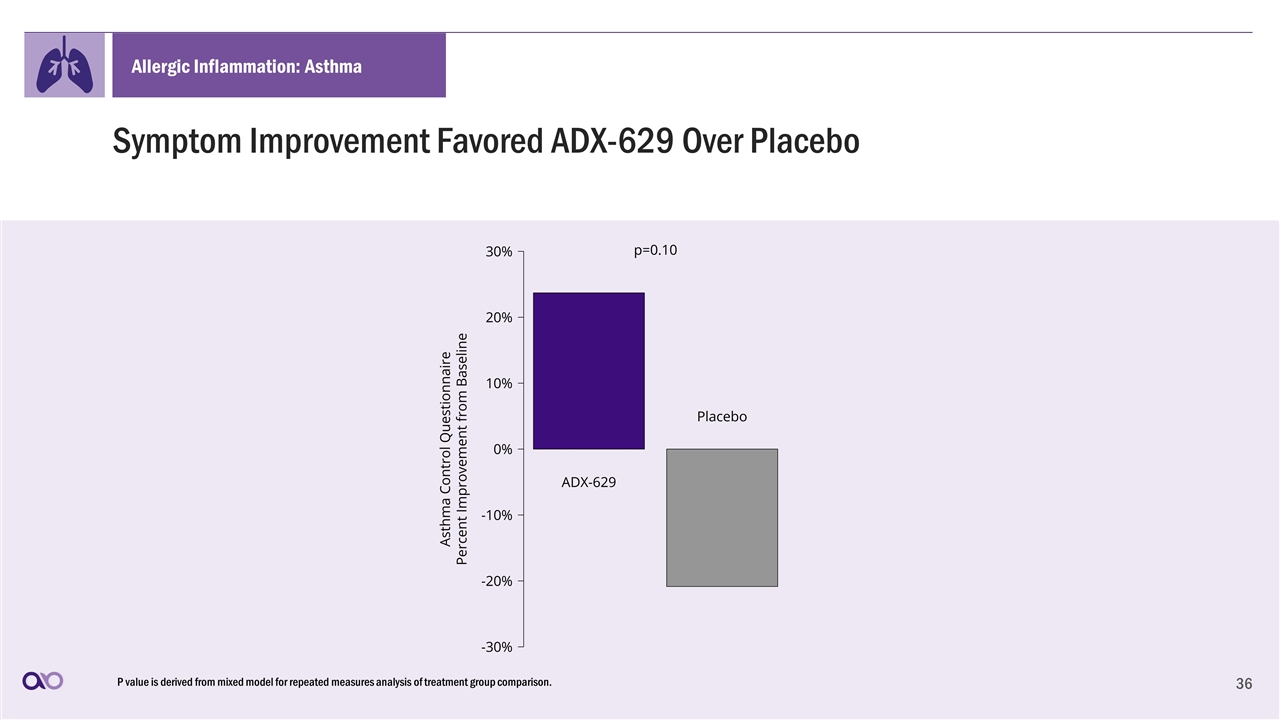
Symptom Improvement Favored ADX-629 Over Placebo P value is derived from mixed model for repeated measures analysis of treatment group comparison. Allergic Inflammation: Asthma
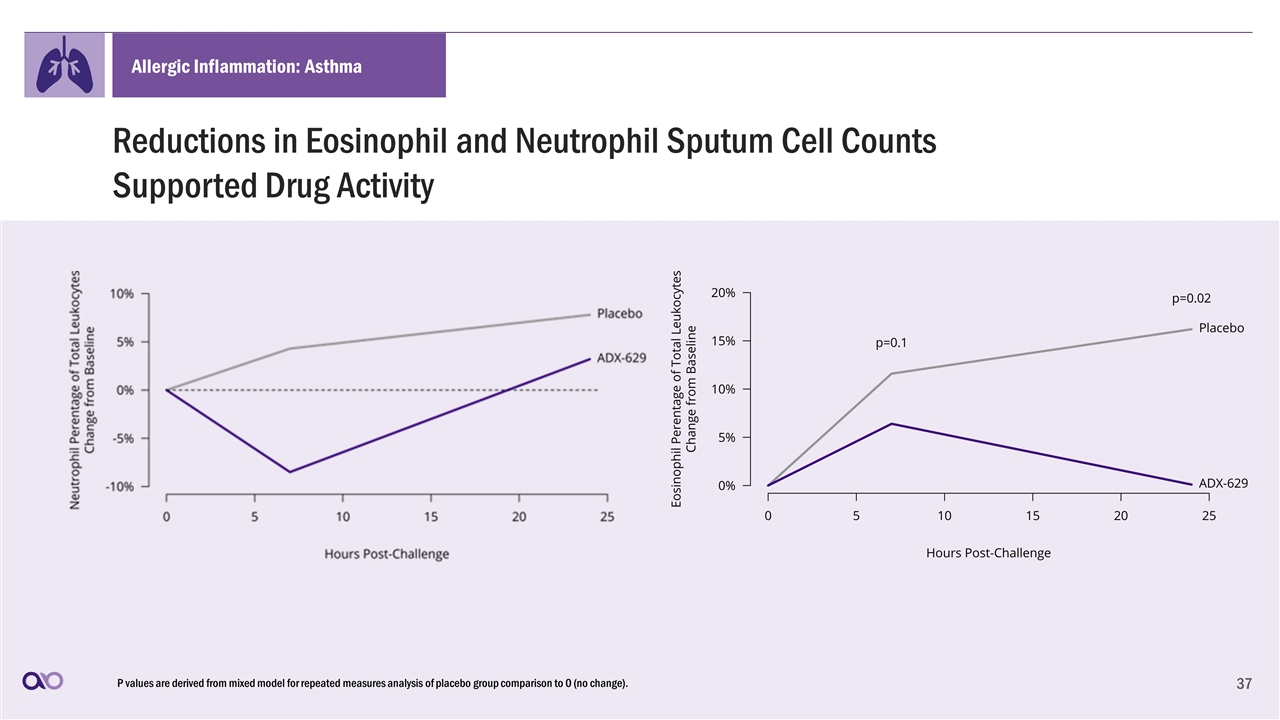
Reductions in Eosinophil and Neutrophil Sputum Cell Counts Supported Drug Activity P values are derived from mixed model for repeated measures analysis of placebo group comparison to 0 (no change). Allergic Inflammation: Asthma
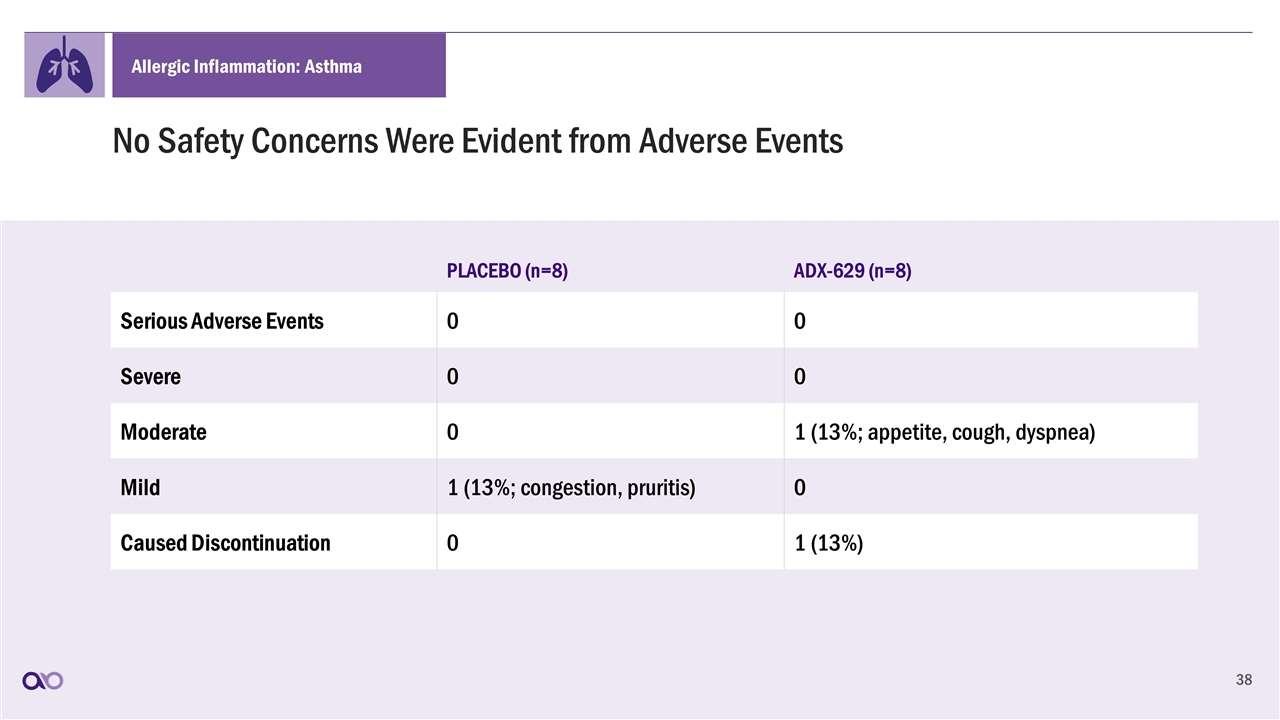
No Safety Concerns Were Evident from Adverse Events PLACEBO (n=8) ADX-629 (n=8) Serious Adverse Events 0 0 Severe 0 0 Moderate 0 1 (13%; appetite, cough, dyspnea) Mild 1 (13%; congestion, pruritis) 0 Caused Discontinuation 0 1 (13%) Allergic Inflammation: Asthma

Reduction in Plasma Malondialdehyde Levels Correlated with Clinical Response P value is derived from mixed model for repeated measures analysis of change from baseline over all post-baseline assessments. Allergic Inflammation: Asthma
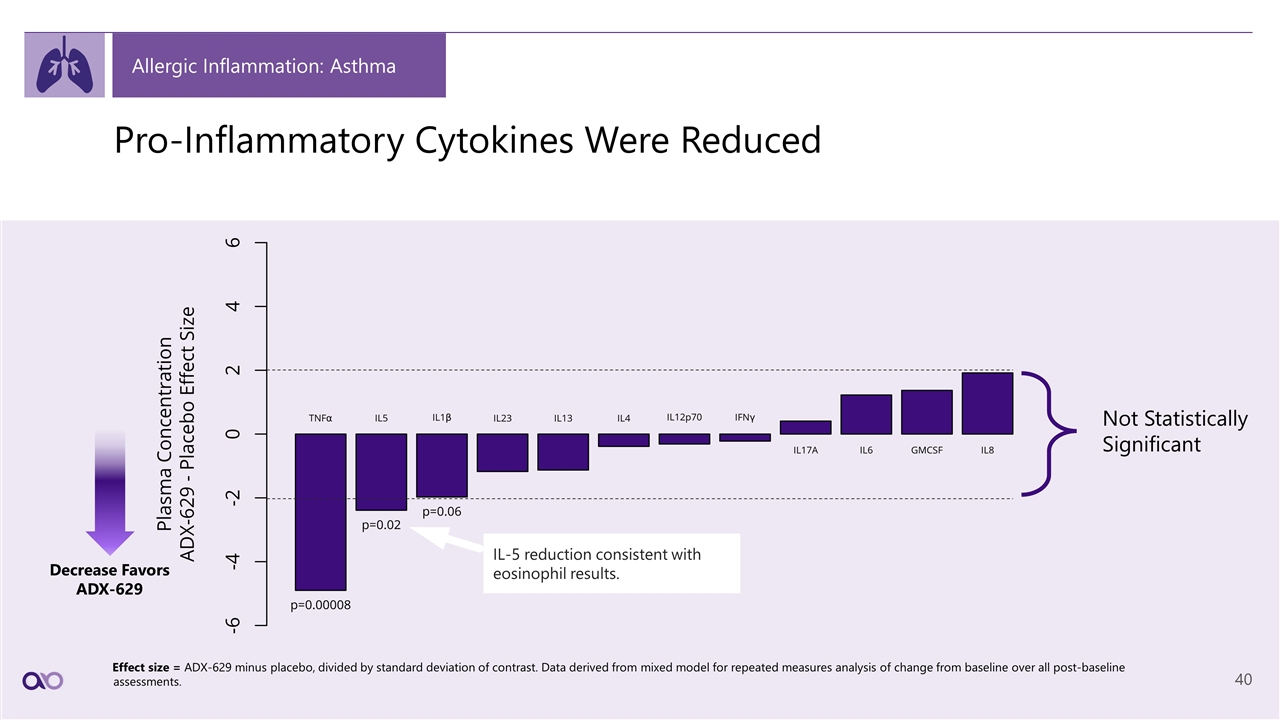
Pro-Inflammatory Cytokines Were Reduced 40 Effect size = ADX-629 minus placebo, divided by standard deviation of contrast. Data derived from mixed model for repeated measures analysis of change from baseline over all post-baseline assessments. Allergic Inflammation: Asthma Not Statistically Significant IL-5 reduction consistent with eosinophil results. Decrease Favors ADX-629
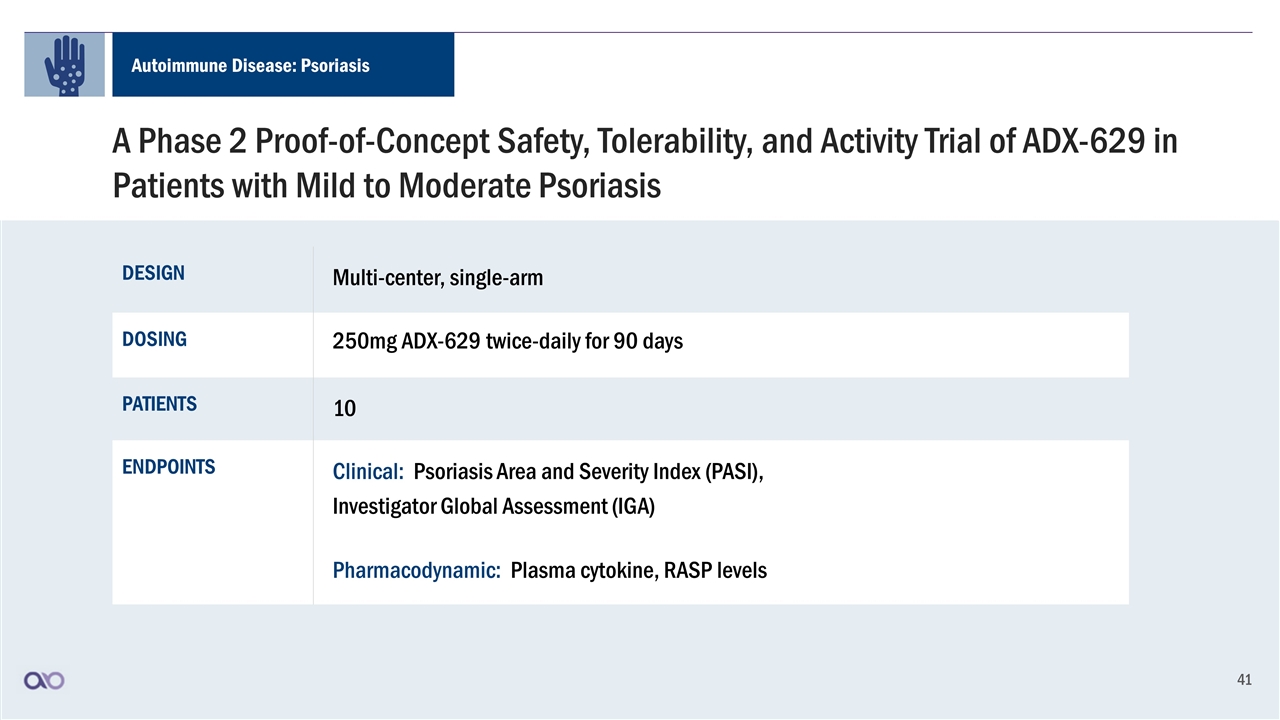
A Phase 2 Proof-of-Concept Safety, Tolerability, and Activity Trial of ADX-629 in Patients with Mild to Moderate Psoriasis DESIGN Multi-center, single-arm DOSING 250mg ADX-629 twice-daily for 90 days PATIENTS 10 ENDPOINTS Clinical: Psoriasis Area and Severity Index (PASI), Investigator Global Assessment (IGA) Pharmacodynamic: Plasma cytokine, RASP levels Autoimmune Disease: Psoriasis
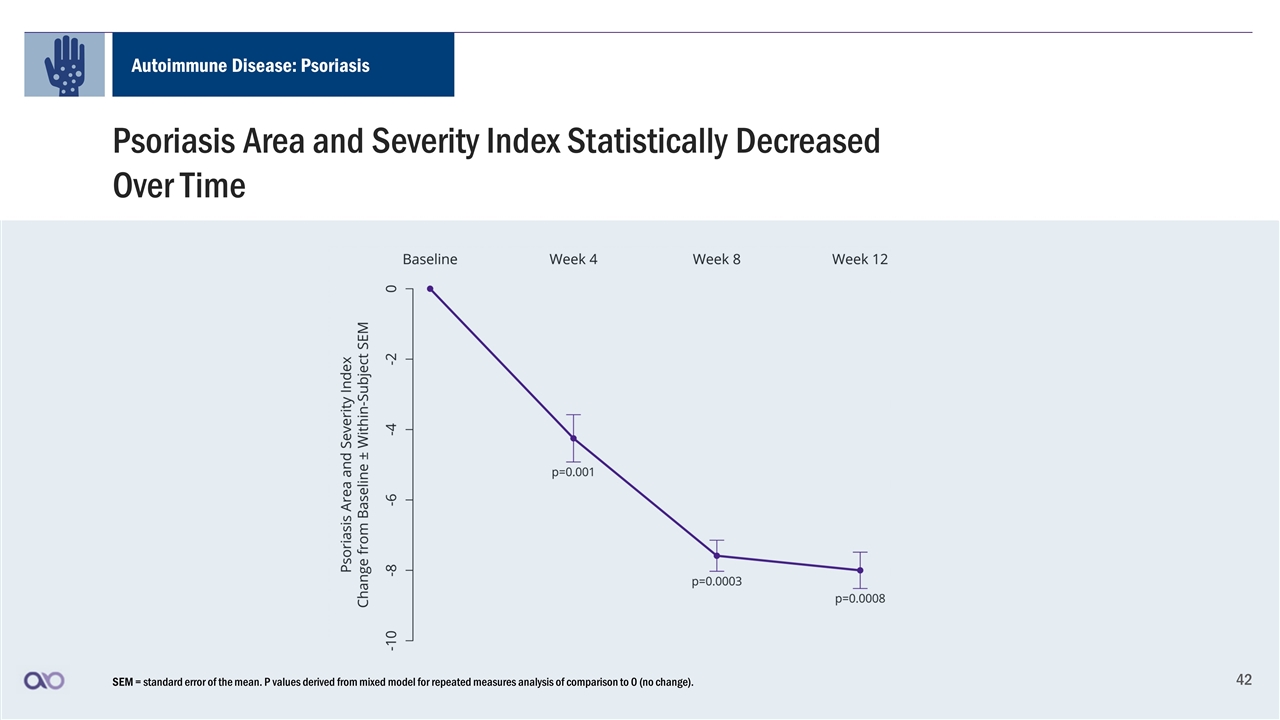
Psoriasis Area and Severity Index Statistically Decreased Over Time Autoimmune Disease: Psoriasis SEM = standard error of the mean. P values derived from mixed model for repeated measures analysis of comparison to 0 (no change).
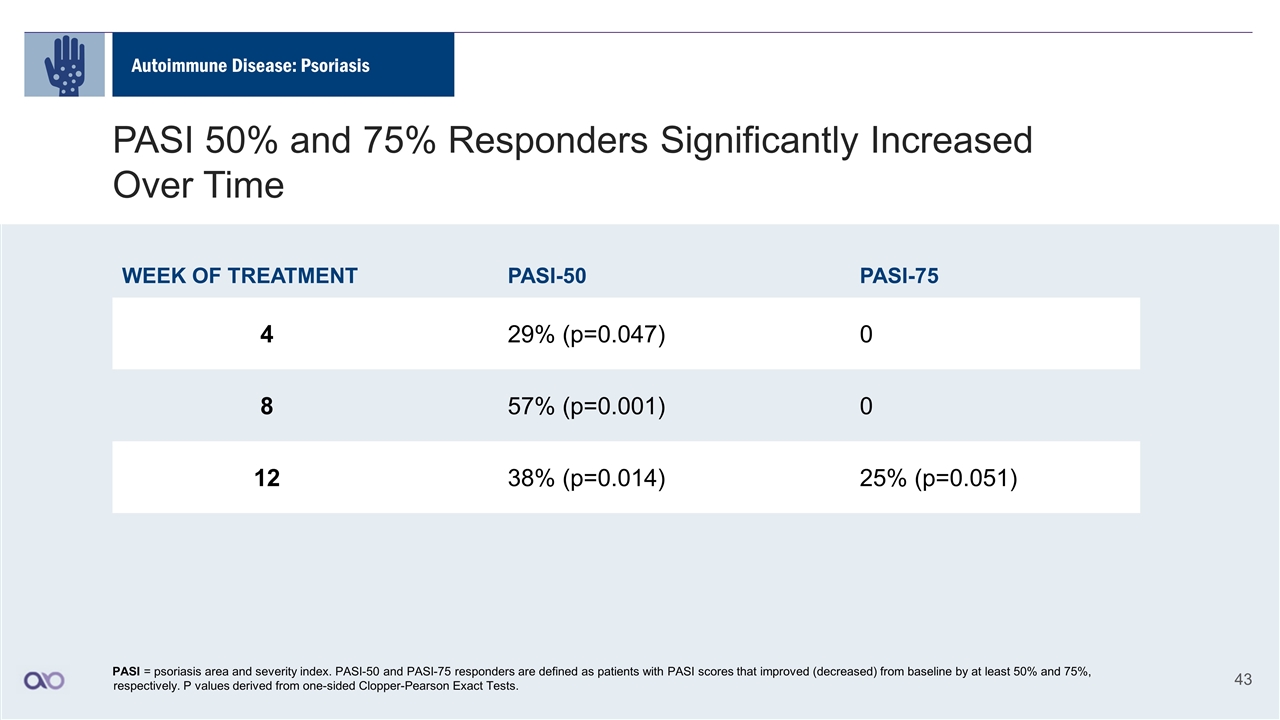
PASI = psoriasis area and severity index. PASI-50 and PASI-75 responders are defined as patients with PASI scores that improved (decreased) from baseline by at least 50% and 75%, respectively. P values derived from one-sided Clopper-Pearson Exact Tests. WEEK OF TREATMENT PASI-50 PASI-75 4 29% (p=0.047) 0 8 57% (p=0.001) 0 12 38% (p=0.014) 25% (p=0.051) PASI 50% and 75% Responders Significantly Increased Over Time Autoimmune Disease: Psoriasis
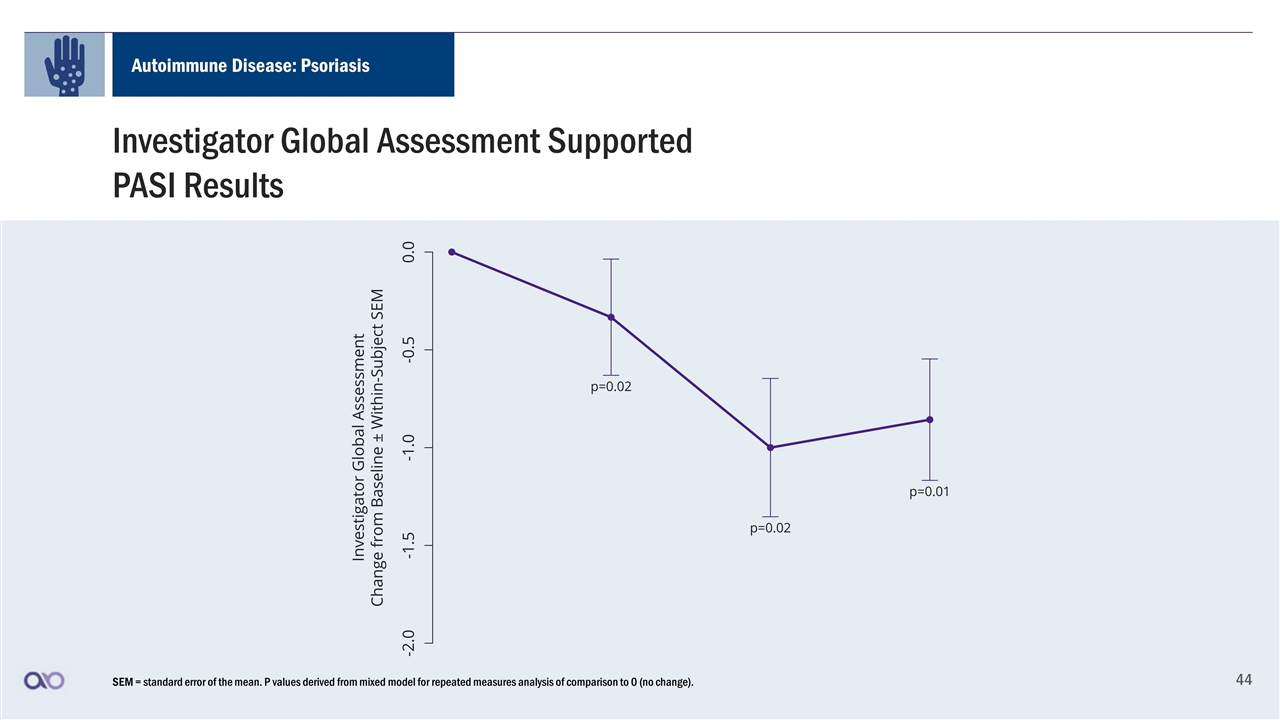
Investigator Global Assessment Supported PASI Results SEM = standard error of the mean. P values derived from mixed model for repeated measures analysis of comparison to 0 (no change). Autoimmune Disease: Psoriasis
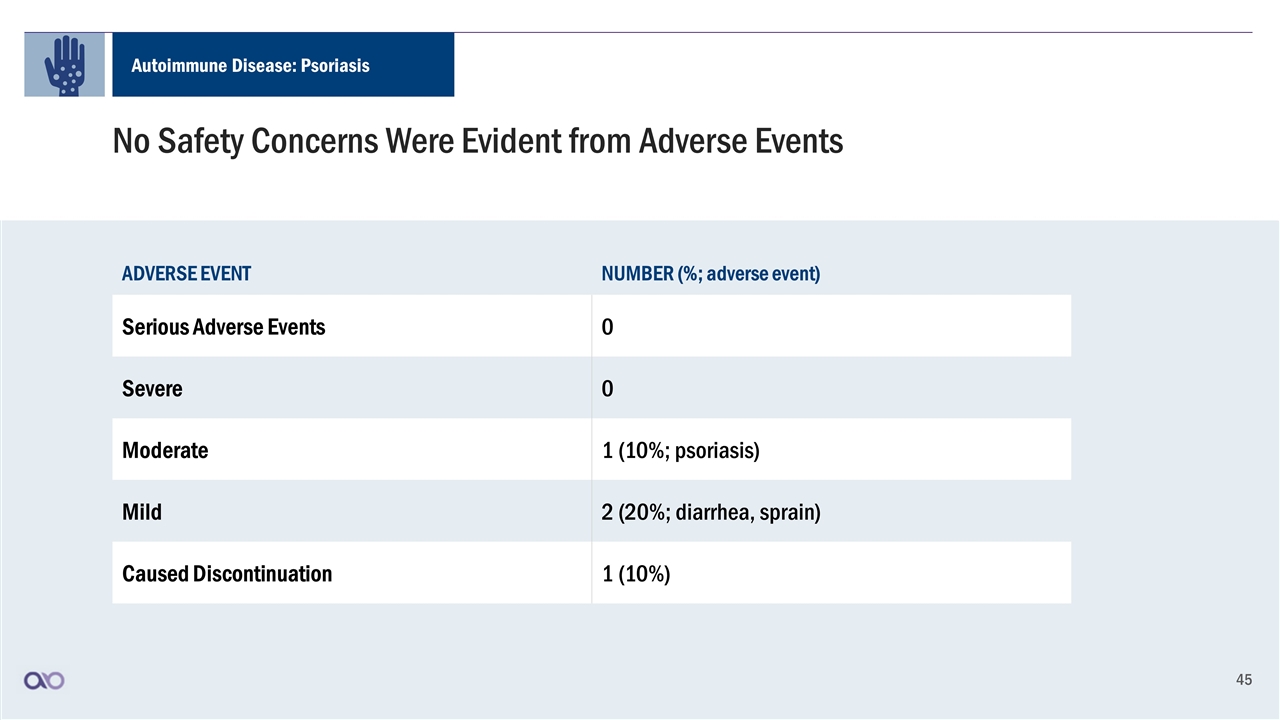
No Safety Concerns Were Evident from Adverse Events ADVERSE EVENT NUMBER (%; adverse event) Serious Adverse Events 0 Severe 0 Moderate 1 (10%; psoriasis) Mild 2 (20%; diarrhea, sprain) Caused Discontinuation 1 (10%) Autoimmune Disease: Psoriasis
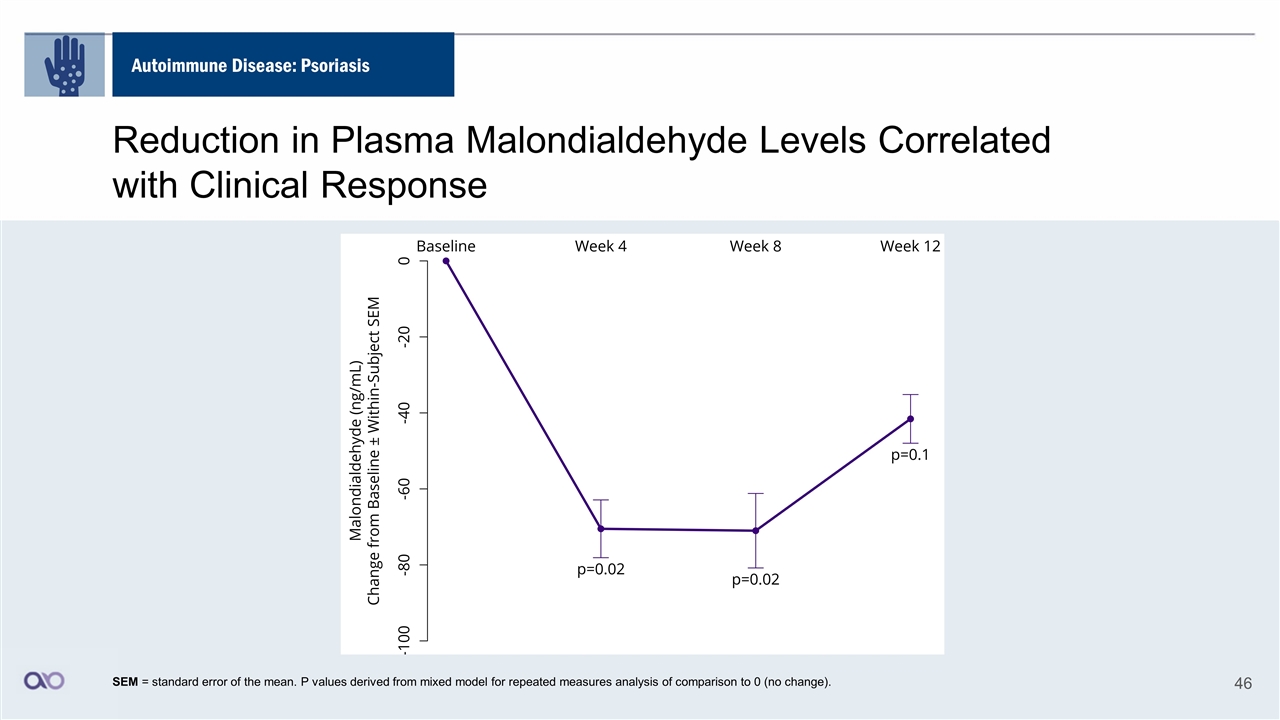
Reduction in Plasma Malondialdehyde Levels Correlated with Clinical Response Autoimmune Disease: Psoriasis SEM = standard error of the mean. P values derived from mixed model for repeated measures analysis of comparison to 0 (no change).
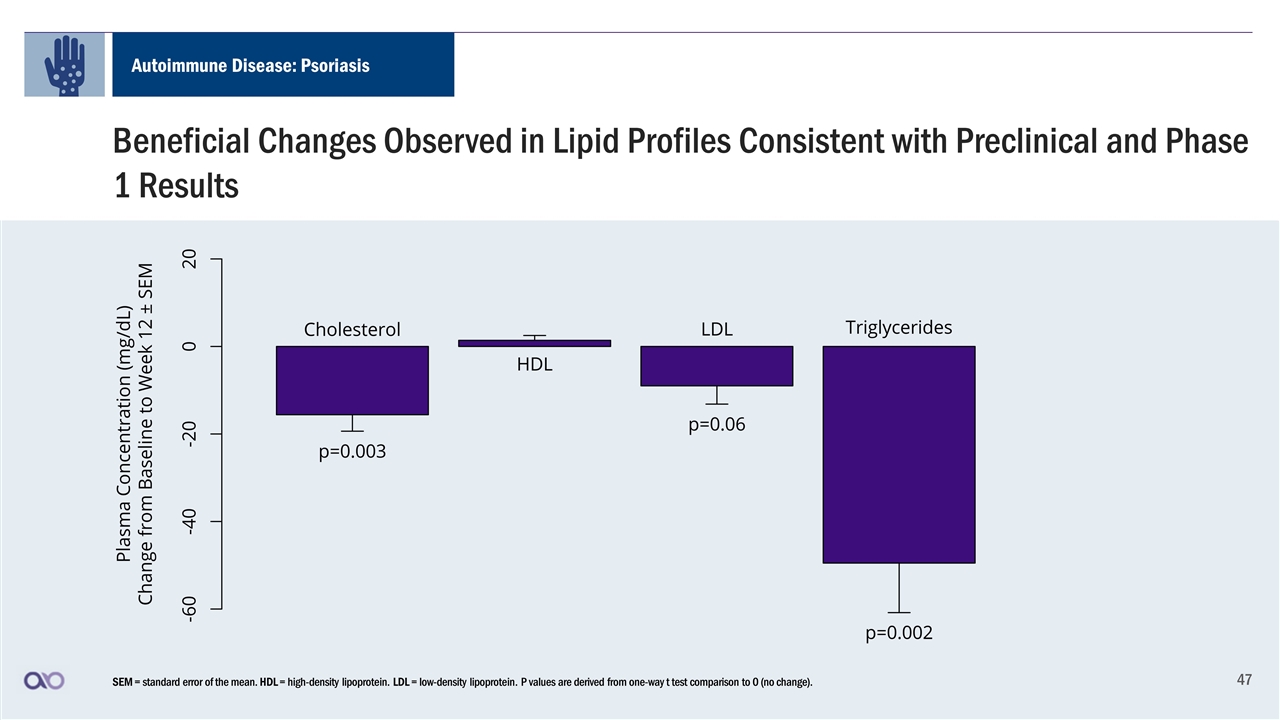
Beneficial Changes Observed in Lipid Profiles Consistent with Preclinical and Phase 1 Results SEM = standard error of the mean. HDL = high-density lipoprotein. LDL = low-density lipoprotein. P values are derived from one-way t test comparison to 0 (no change). Autoimmune Disease: Psoriasis
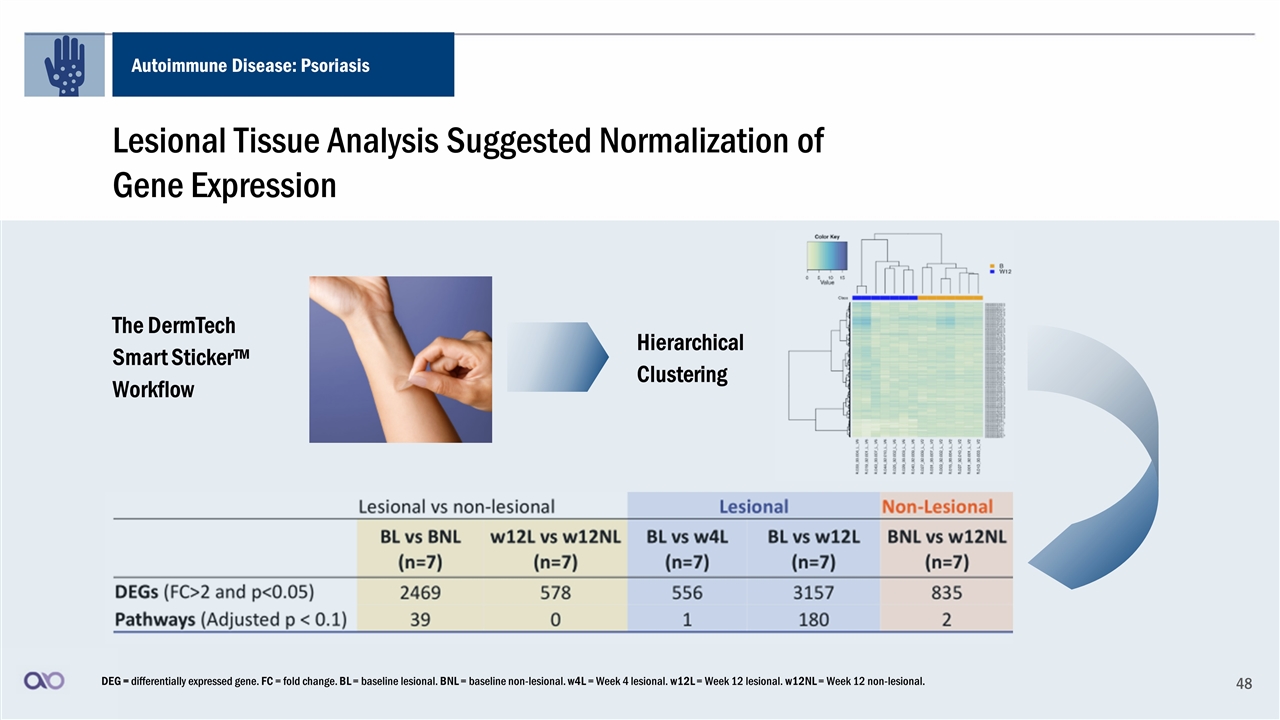
Lesional Tissue Analysis Suggested Normalization of Gene Expression DEG = differentially expressed gene. FC = fold change. BL = baseline lesional. BNL = baseline non-lesional. w4L = Week 4 lesional. w12L = Week 12 lesional. w12NL = Week 12 non-lesional. Autoimmune Disease: Psoriasis The DermTech Smart Sticker™ Workflow Hierarchical Clustering
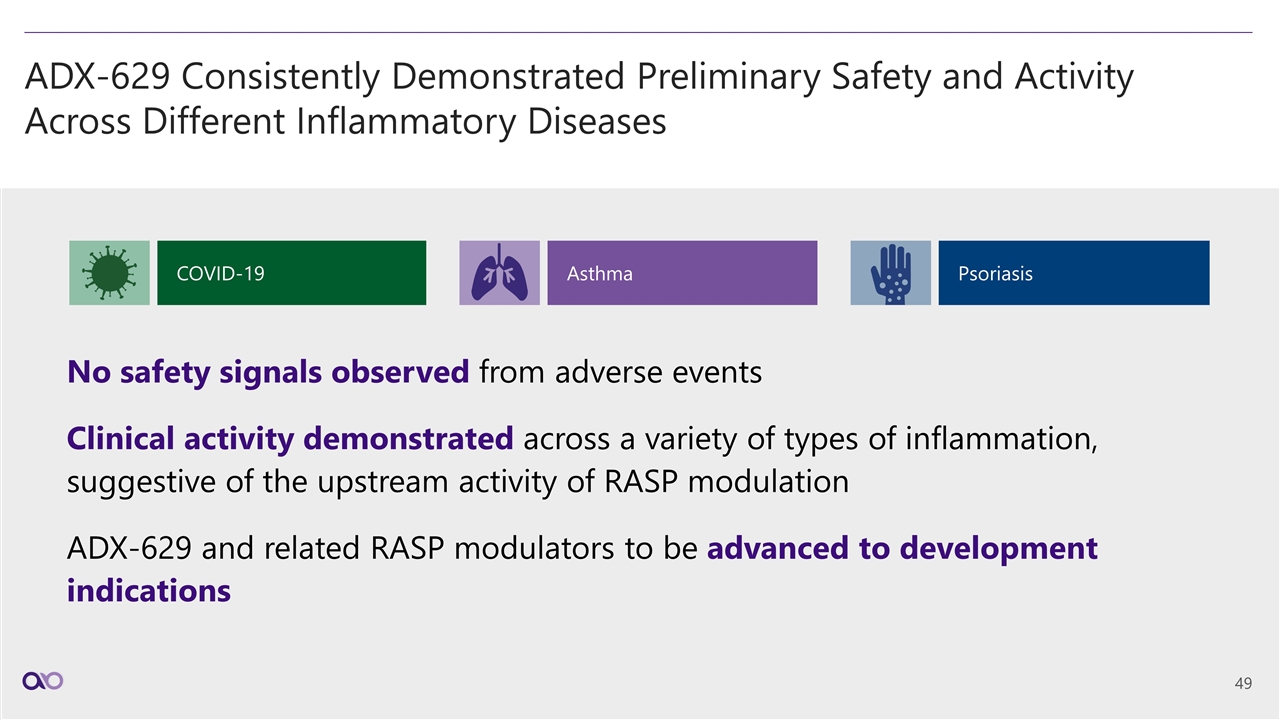
ADX-629 Consistently Demonstrated Preliminary Safety and Activity Across Different Inflammatory Diseases No safety signals observed from adverse events Clinical activity demonstrated across a variety of types of inflammation, suggestive of the upstream activity of RASP modulation ADX-629 and related RASP modulators to be advanced to development indications 49 Psoriasis Asthma COVID-19
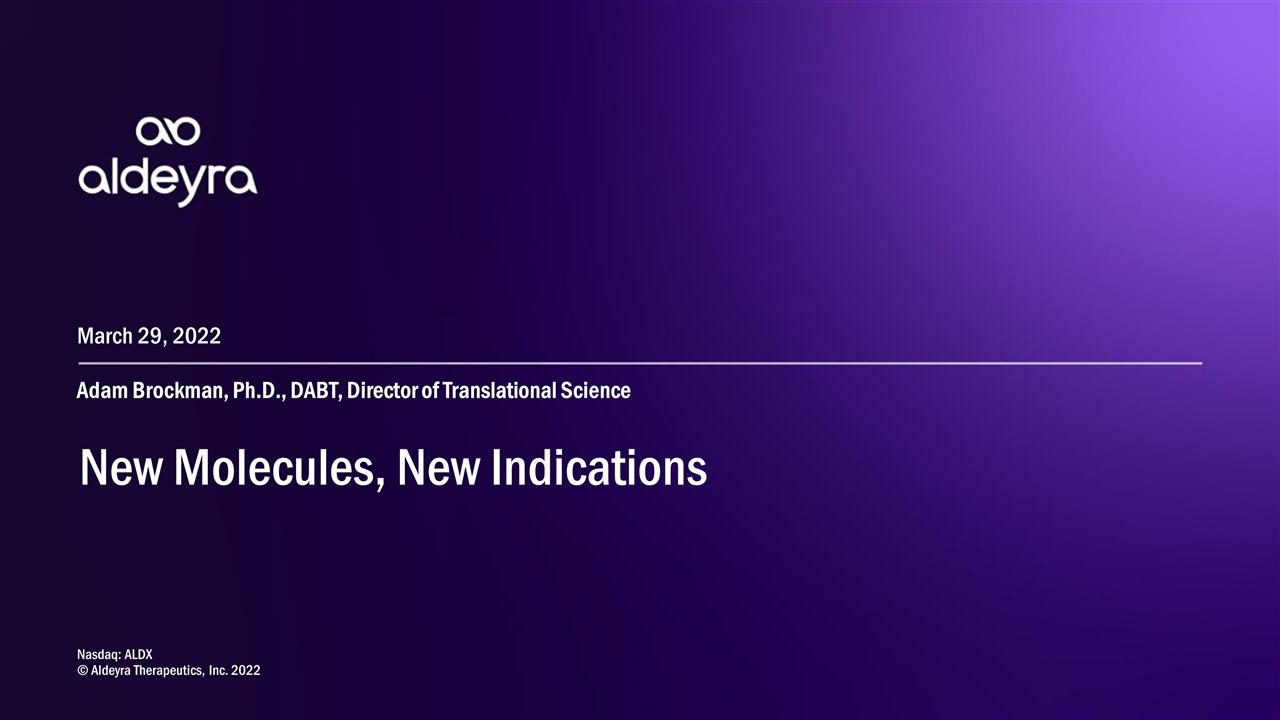
New Molecules, New Indications Nasdaq: ALDX © Aldeyra Therapeutics, Inc. 2022 March 29, 2022 Adam Brockman, Ph.D., DABT, Director of Translational Science
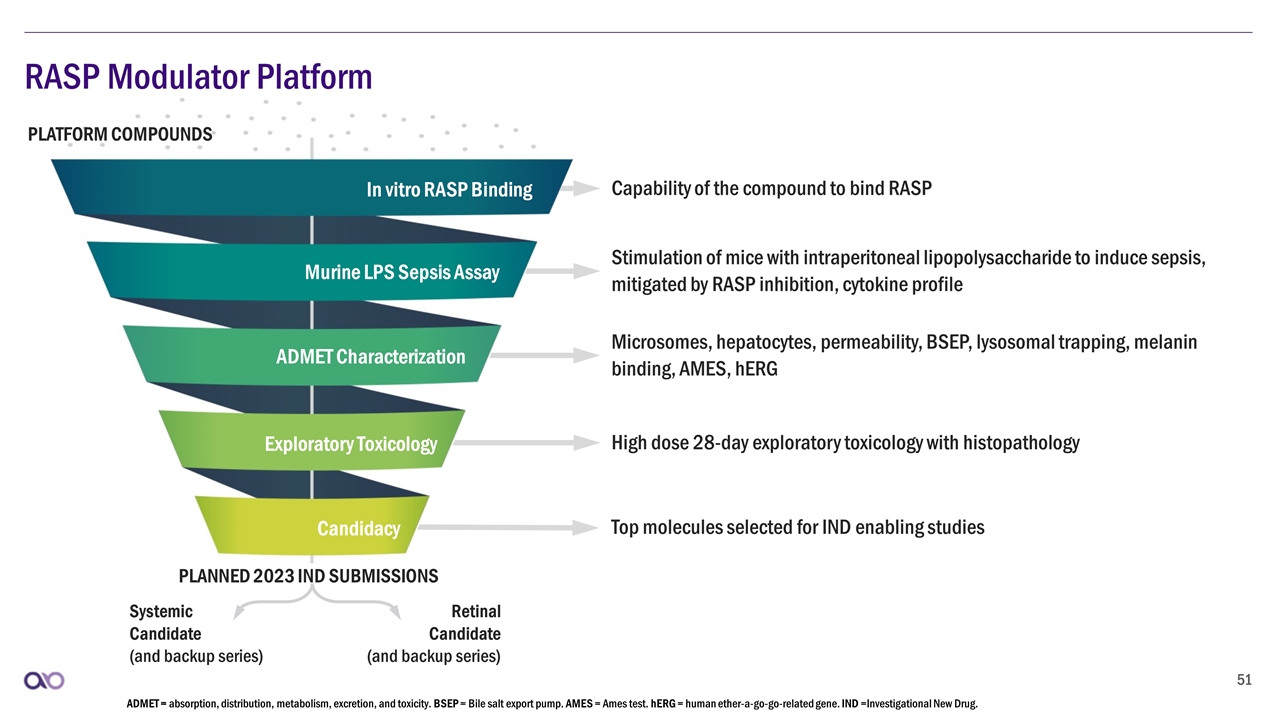
RASP Modulator Platform PLANNED 2023 IND SUBMISSIONS Systemic Candidate (and backup series) Retinal Candidate (and backup series) Capability of the compound to bind RASP In vitro RASP Binding Stimulation of mice with intraperitoneal lipopolysaccharide to induce sepsis, mitigated by RASP inhibition, cytokine profile Murine LPS Sepsis Assay Microsomes, hepatocytes, permeability, BSEP, lysosomal trapping, melanin binding, AMES, hERG ADMET Characterization High dose 28-day exploratory toxicology with histopathology Exploratory Toxicology Top molecules selected for IND enabling studies Candidacy PLATFORM COMPOUNDS ADMET = absorption, distribution, metabolism, excretion, and toxicity. BSEP = Bile salt export pump. AMES = Ames test. hERG = human ether-a-go-go-related gene. IND =Investigational New Drug.
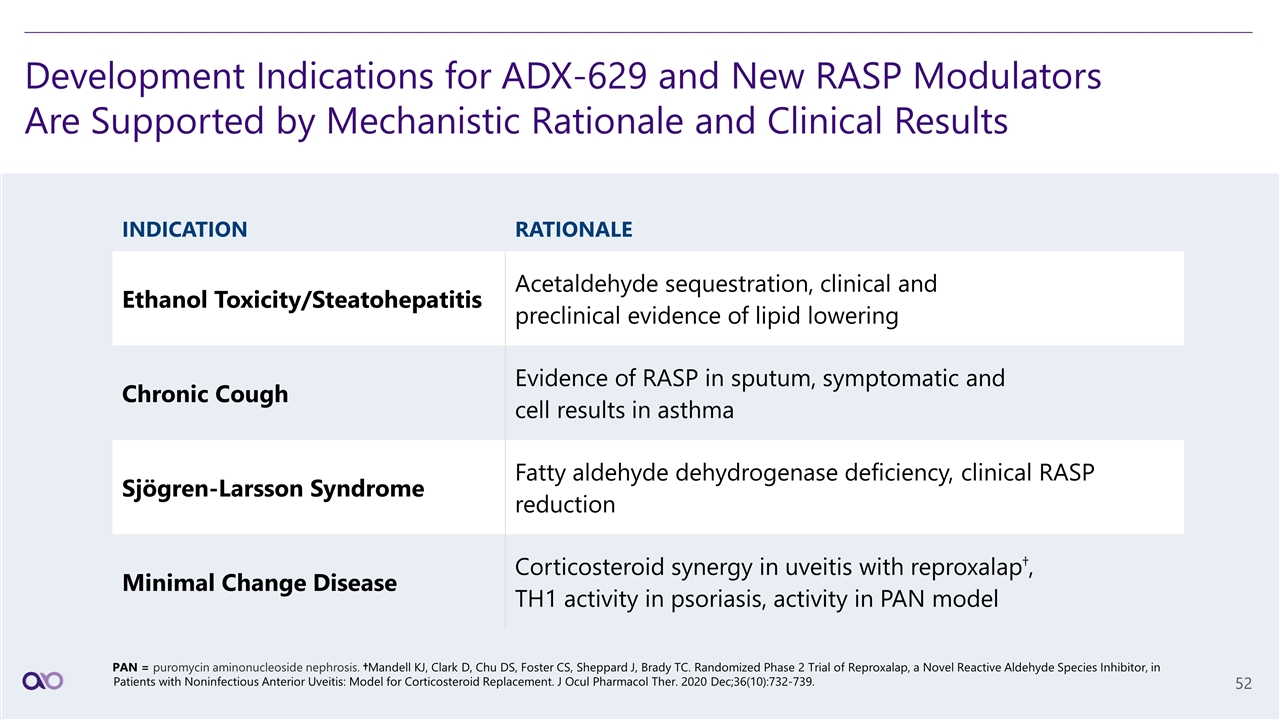
Development Indications for ADX-629 and New RASP Modulators Are Supported by Mechanistic Rationale and Clinical Results INDICATION RATIONALE Ethanol Toxicity/Steatohepatitis Acetaldehyde sequestration, clinical and preclinical evidence of lipid lowering Chronic Cough Evidence of RASP in sputum, symptomatic and cell results in asthma Sjögren-Larsson Syndrome Fatty aldehyde dehydrogenase deficiency, clinical RASP reduction Minimal Change Disease Corticosteroid synergy in uveitis with reproxalap†, TH1 activity in psoriasis, activity in PAN model PAN = puromycin aminonucleoside nephrosis. †Mandell KJ, Clark D, Chu DS, Foster CS, Sheppard J, Brady TC. Randomized Phase 2 Trial of Reproxalap, a Novel Reactive Aldehyde Species Inhibitor, in Patients with Noninfectious Anterior Uveitis: Model for Corticosteroid Replacement. J Ocul Pharmacol Ther. 2020 Dec;36(10):732-739.
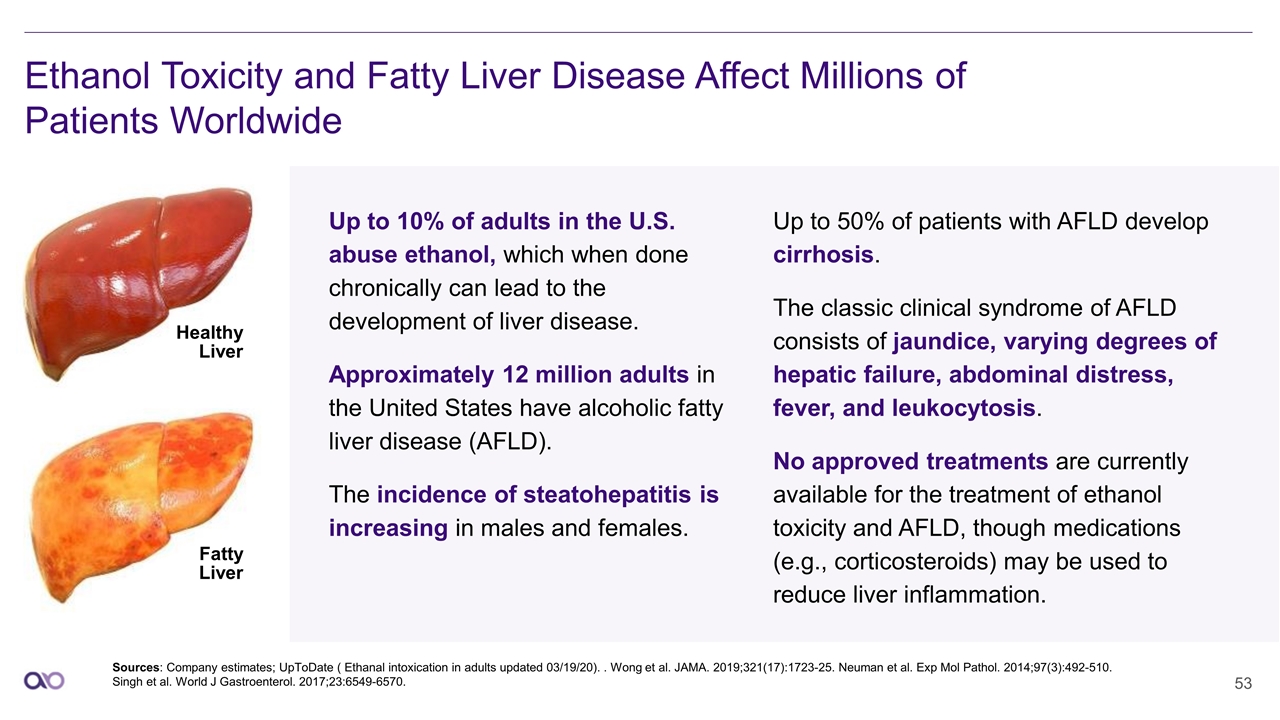
53 Ethanol Toxicity and Fatty Liver Disease Affect Millions of Patients Worldwide Up to 10% of adults in the U.S. abuse ethanol, which when done chronically can lead to the development of liver disease. Approximately 12 million adults in the United States have alcoholic fatty liver disease (AFLD). The incidence of steatohepatitis is increasing in males and females. Sources: Company estimates; UpToDate ( Ethanal intoxication in adults updated 03/19/20). . Wong et al. JAMA. 2019;321(17):1723-25. Neuman et al. Exp Mol Pathol. 2014;97(3):492-510. Singh et al. World J Gastroenterol. 2017;23:6549-6570. Up to 50% of patients with AFLD develop cirrhosis. The classic clinical syndrome of AFLD consists of jaundice, varying degrees of hepatic failure, abdominal distress, fever, and leukocytosis. No approved treatments are currently available for the treatment of ethanol toxicity and AFLD, though medications (e.g., corticosteroids) may be used to reduce liver inflammation. Healthy Liver Fatty Liver
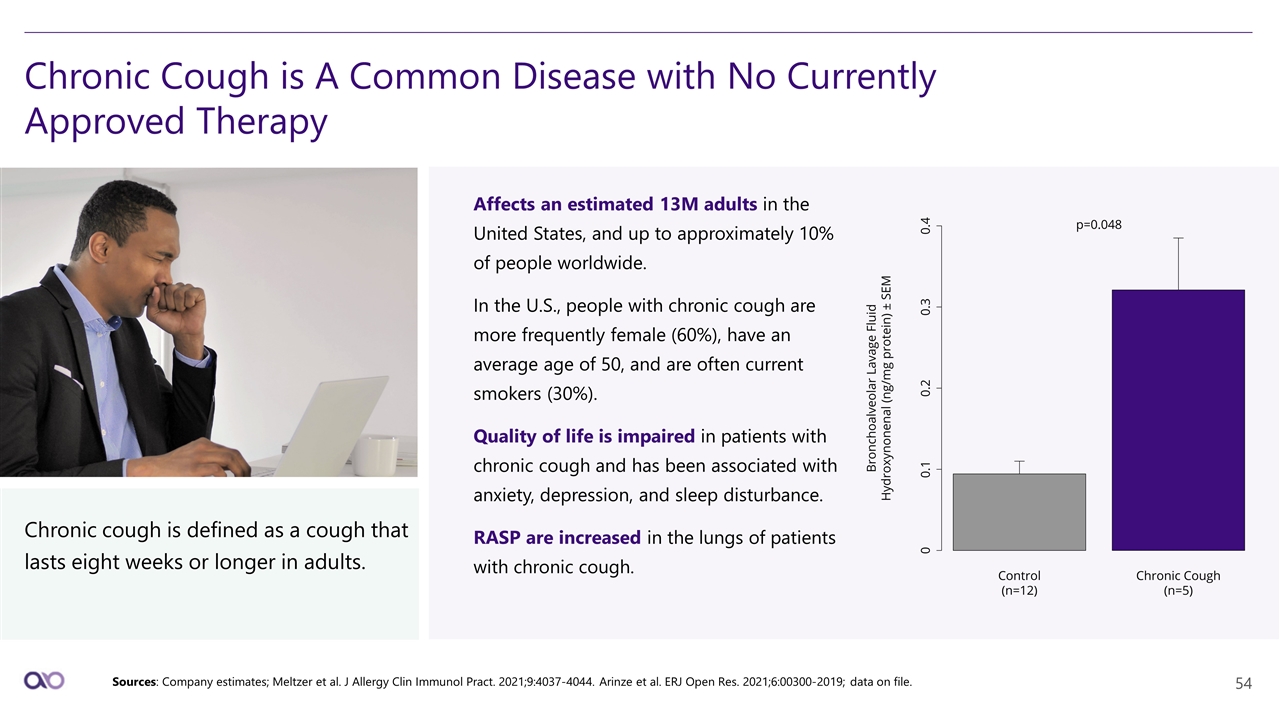
54 Chronic Cough is A Common Disease with No Currently Approved Therapy Chronic cough is defined as a cough that lasts eight weeks or longer in adults. Affects an estimated 13M adults in the United States, and up to approximately 10% of people worldwide. In the U.S., people with chronic cough are more frequently female (60%), have an average age of 50, and are often current smokers (30%). Quality of life is impaired in patients with chronic cough and has been associated with anxiety, depression, and sleep disturbance. RASP are increased in the lungs of patients with chronic cough. Sources: Company estimates; Meltzer et al. J Allergy Clin Immunol Pract. 2021;9:4037-4044. Arinze et al. ERJ Open Res. 2021;6:00300-2019; data on file.
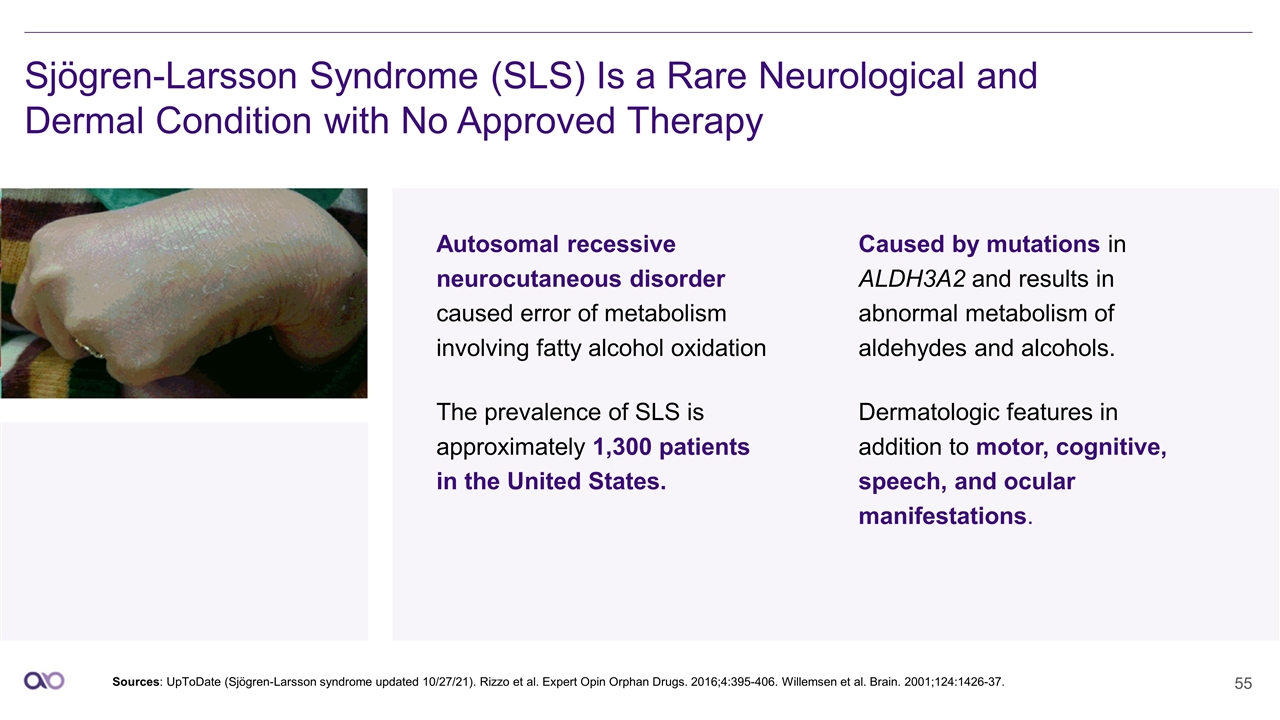
55 Sjögren-Larsson Syndrome (SLS) Is a Rare Neurological and Dermal Condition with No Approved Therapy Autosomal recessive neurocutaneous disorder caused error of metabolism involving fatty alcohol oxidation The prevalence of SLS is approximately 1,300 patients in the United States. Sources: UpToDate (Sjögren-Larsson syndrome updated 10/27/21). Rizzo et al. Expert Opin Orphan Drugs. 2016;4:395-406. Willemsen et al. Brain. 2001;124:1426-37. Caused by mutations in ALDH3A2 and results in abnormal metabolism of aldehydes and alcohols. Dermatologic features in addition to motor, cognitive, speech, and ocular manifestations.
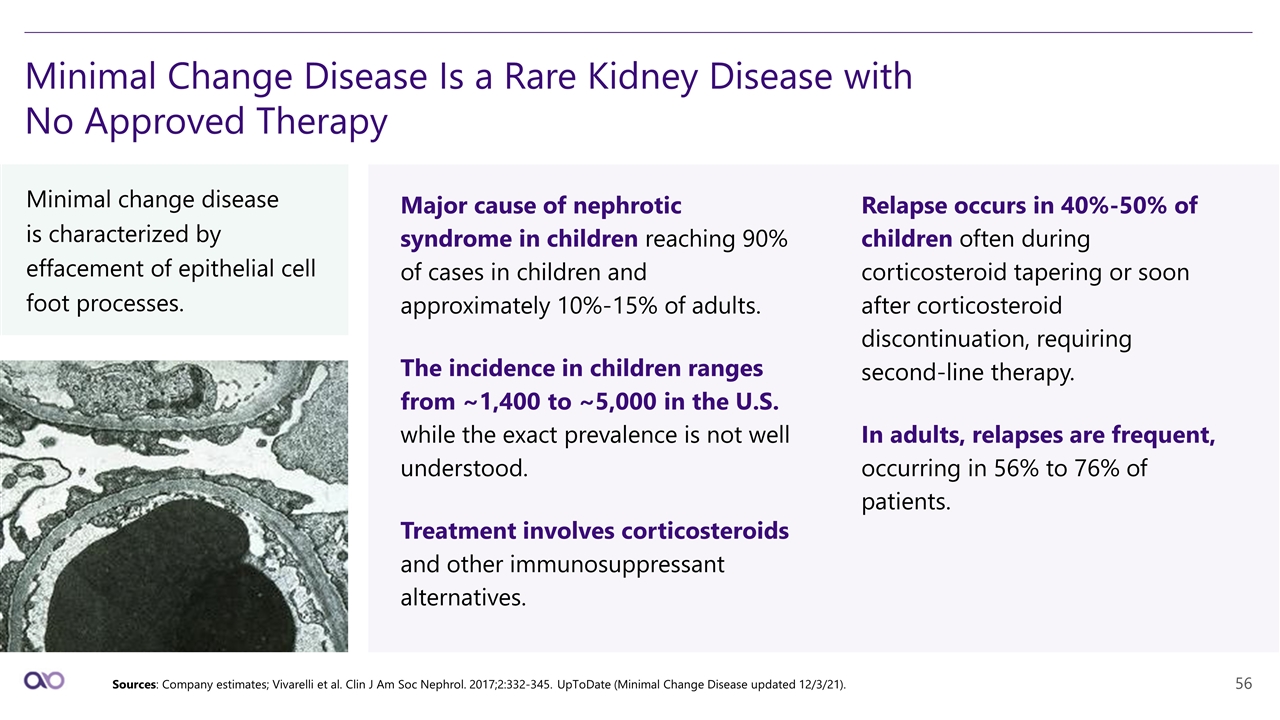
56 Minimal Change Disease Is a Rare Kidney Disease with No Approved Therapy Minimal change disease is characterized by effacement of epithelial cell foot processes. Major cause of nephrotic syndrome in children reaching 90% of cases in children and approximately 10%-15% of adults. The incidence in children ranges from ~1,400 to ~5,000 in the U.S. while the exact prevalence is not well understood. Treatment involves corticosteroids and other immunosuppressant alternatives. Sources: Company estimates; Vivarelli et al. Clin J Am Soc Nephrol. 2017;2:332-345. UpToDate (Minimal Change Disease updated 12/3/21). Relapse occurs in 40%-50% of children often during corticosteroid tapering or soon after corticosteroid discontinuation, requiring second-line therapy. In adults, relapses are frequent, occurring in 56% to 76% of patients.
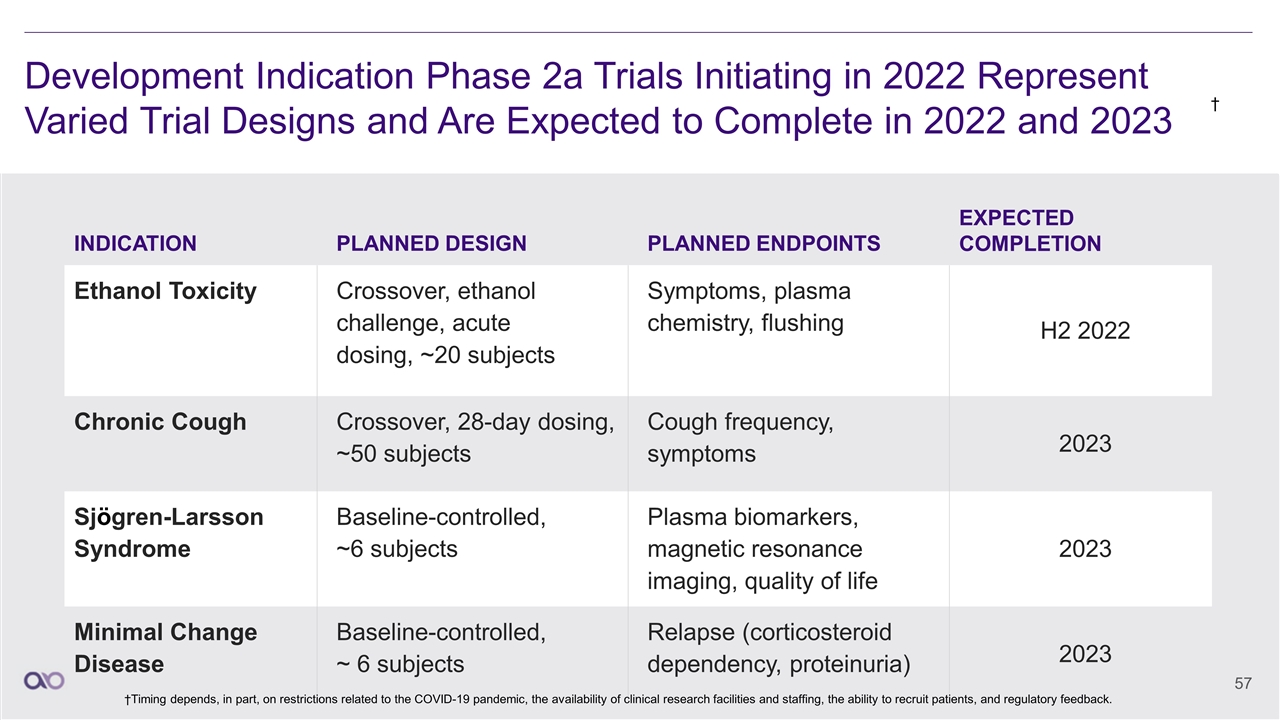
Development Indication Phase 2a Trials Initiating in 2022 Represent Varied Trial Designs and Are Expected to Complete in 2022 and 2023 INDICATION PLANNED DESIGN PLANNED ENDPOINTS EXPECTED COMPLETION Ethanol Toxicity Crossover, ethanol challenge, acute dosing, ~20 subjects Symptoms, plasma chemistry, flushing H2 2022 Chronic Cough Crossover, 28-day dosing, ~50 subjects Cough frequency, symptoms 2023 Sjögren-Larsson Syndrome Baseline-controlled, ~6 subjects Plasma biomarkers, magnetic resonance imaging, quality of life 2023 Minimal Change Disease Baseline-controlled, ~ 6 subjects Relapse (corticosteroid dependency, proteinuria) 2023 †Timing depends, in part, on restrictions related to the COVID-19 pandemic, the availability of clinical research facilities and staffing, the ability to recruit patients, and regulatory feedback. †

Questions March 29, 2022 Nasdaq: ALDX © Aldeyra Therapeutics, Inc. 2022

Concluding Remarks Todd C. Brady, M.D., Ph.D., Chief Executive Officer March 29, 2022 Nasdaq: ALDX © Aldeyra Therapeutics, Inc. 2022
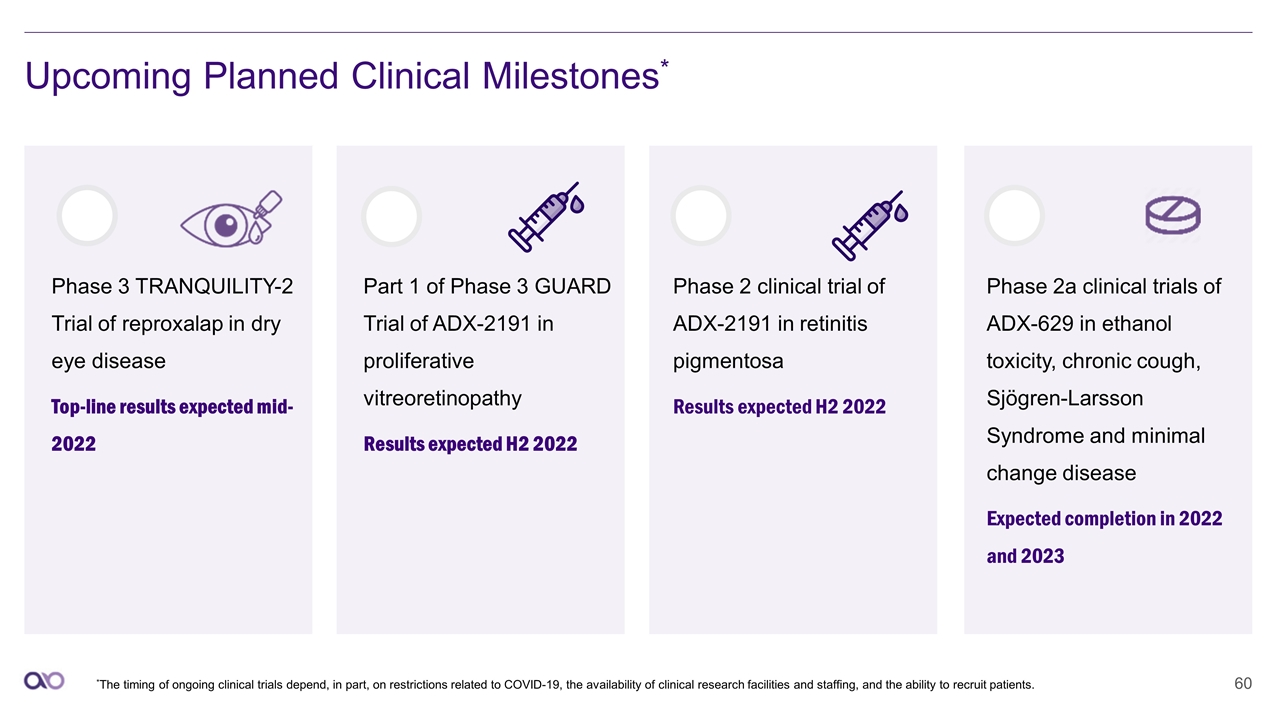
Upcoming Planned Clinical Milestones* *The timing of ongoing clinical trials depend, in part, on restrictions related to COVID-19, the availability of clinical research facilities and staffing, and the ability to recruit patients. Part 1 of Phase 3 GUARD Trial of ADX-2191 in proliferative vitreoretinopathy Results expected H2 2022 Phase 3 TRANQUILITY-2 Trial of reproxalap in dry eye disease Top-line results expected mid-2022 Phase 2 clinical trial of ADX-2191 in retinitis pigmentosa Results expected H2 2022 Phase 2a clinical trials of ADX-629 in ethanol toxicity, chronic cough, Sjögren-Larsson Syndrome and minimal change disease Expected completion in 2022 and 2023
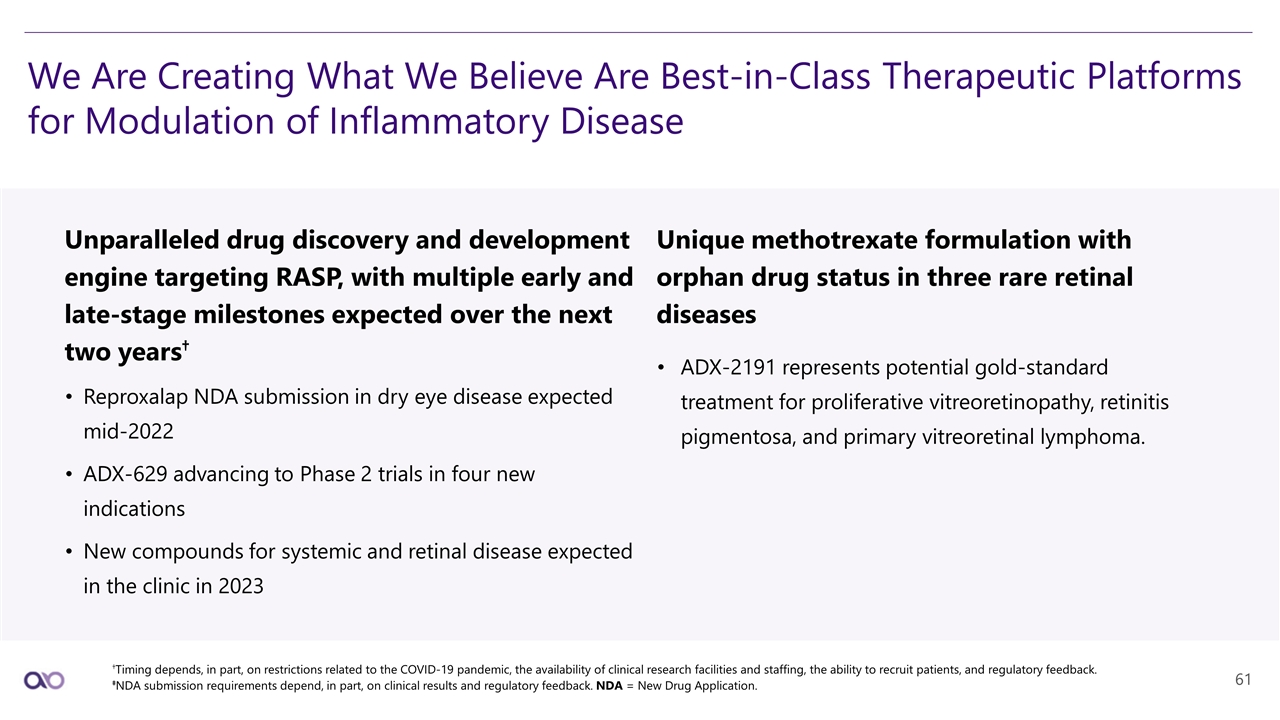
We Are Creating What We Believe Are Best-in-Class Therapeutic Platforms for Modulation of Inflammatory Disease Unparalleled drug discovery and development engine targeting RASP, with multiple early and late-stage milestones expected over the next two years† Reproxalap NDA submission in dry eye disease expected mid-2022 ADX-629 advancing to Phase 2 trials in four new indications New compounds for systemic and retinal disease expected in the clinic in 2023 †Timing depends, in part, on restrictions related to the COVID-19 pandemic, the availability of clinical research facilities and staffing, the ability to recruit patients, and regulatory feedback. ‡NDA submission requirements depend, in part, on clinical results and regulatory feedback. NDA = New Drug Application. Unique methotrexate formulation with orphan drug status in three rare retinal diseases ADX-2191 represents potential gold-standard treatment for proliferative vitreoretinopathy, retinitis pigmentosa, and primary vitreoretinal lymphoma.